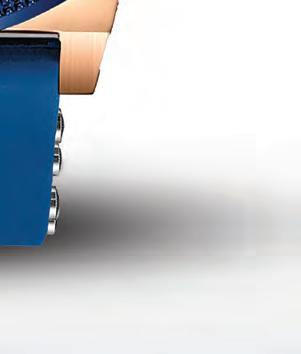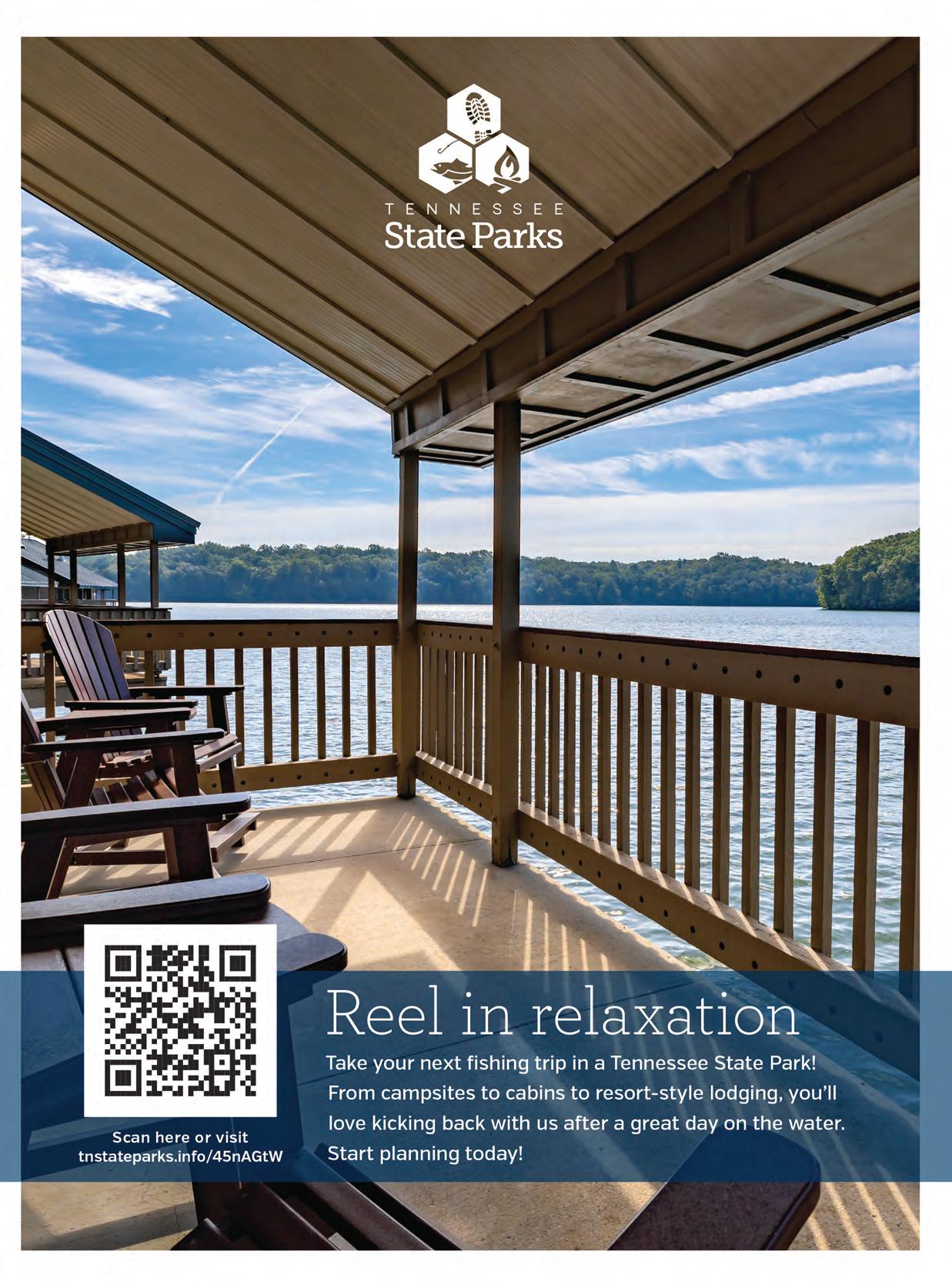

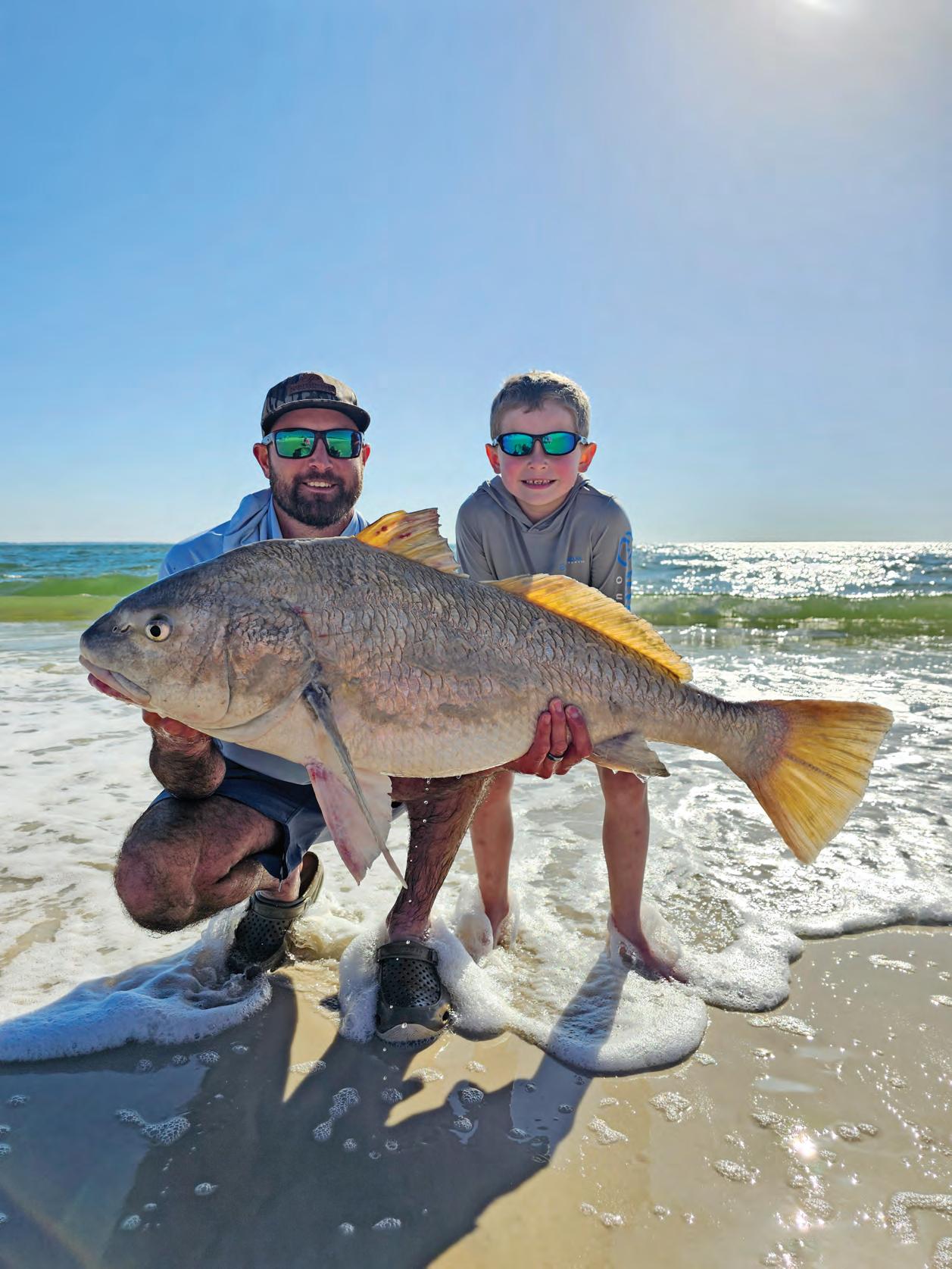
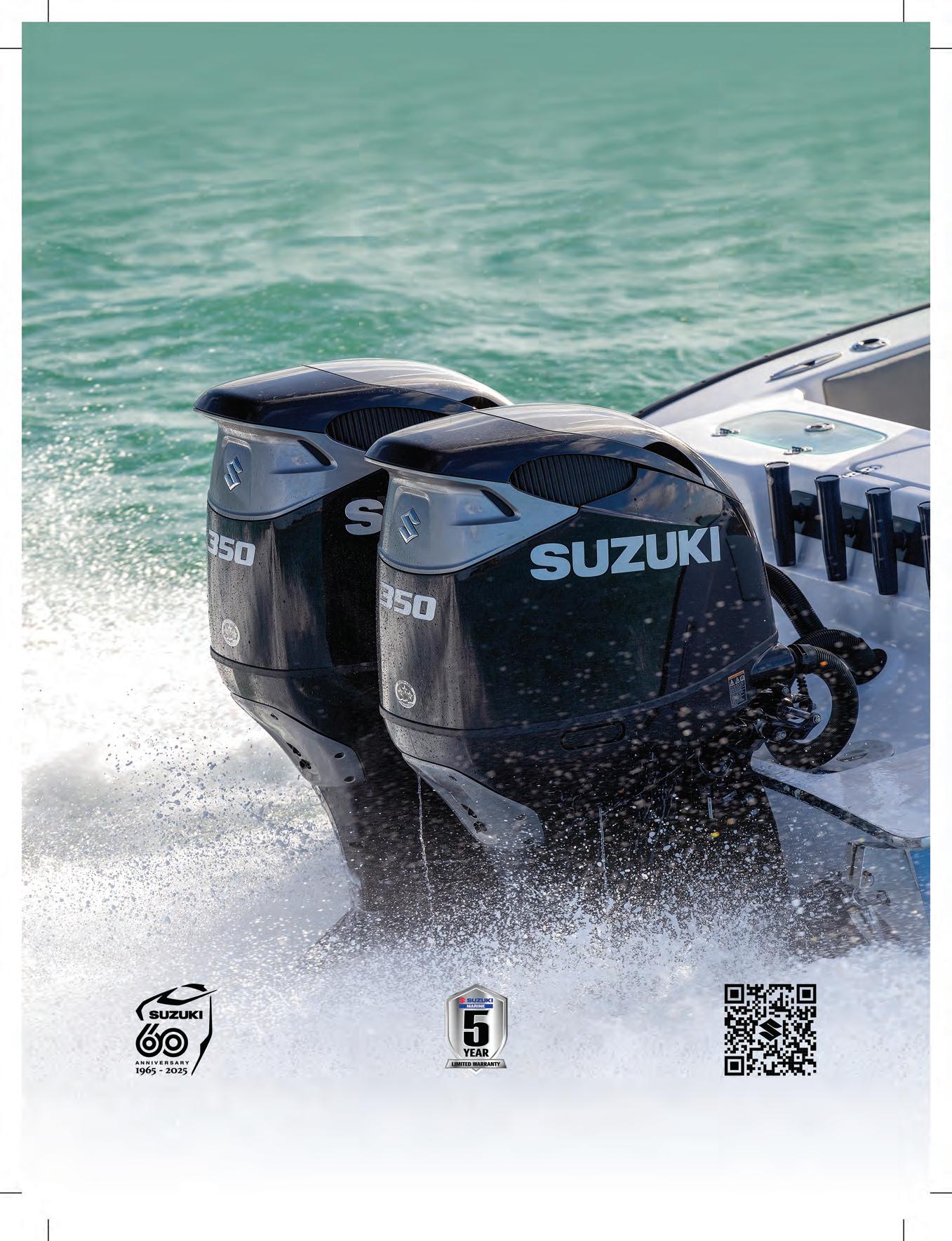

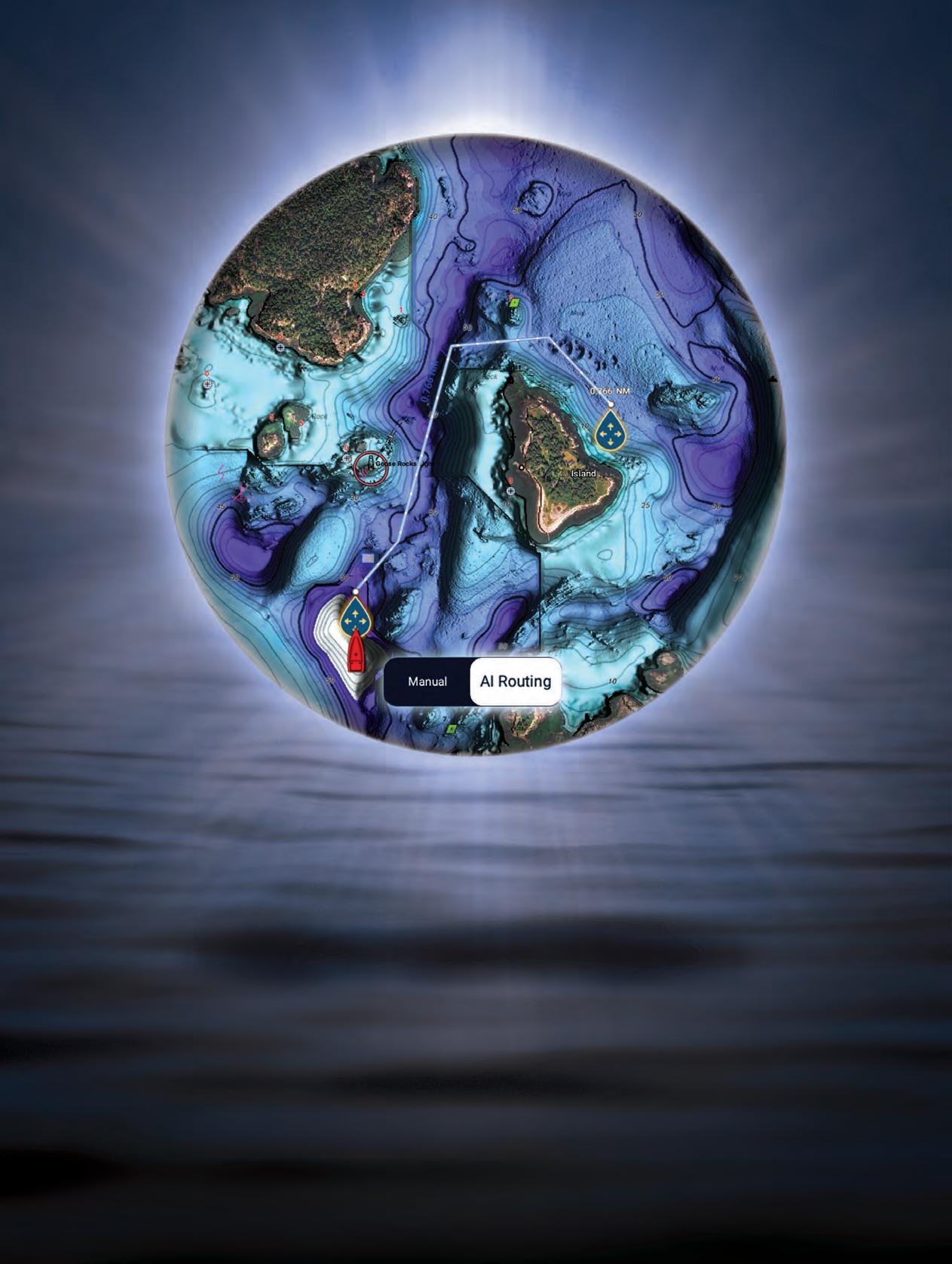
You want AI Routing! Let TZ MAPS with AI Routing make route planning a snap. Don’t take our word for it. Scan here to see for yourself how easy it is!


















You want AI Routing! Let TZ MAPS with AI Routing make route planning a snap. Don’t take our word for it. Scan here to see for yourself how easy it is!











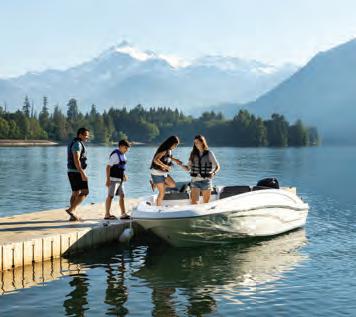






Embarking on the open water is an exhilarating experience, flled with the promise of adventure and relaxation. Whether you’re a seasoned sailor or a weekend cruiser, protecting your vessel with proper insurance is not just a choice—it’s a necessity. Explore the reasons why every boat owner should prioritize boat insurance for a worry-free voyage.
The open water can be unpredictable, with unexpected storms, collisions, or other potential accidents. Boat insurance can give you fnancial protection if there is damage to your vessel, providing coverage for repairs or replacement.
Accidents on the water can result in damage to other boats, docks, or even injuries to passengers. Boat insurance offers liability coverage, which can pay for damages or injuries you’re liable for while boating, up to specifed limits, and lawsuit costs if you’re sued. This includes damage you cause to another watercraft or if someone on or near your boat is injured and you’re found to be legally responsible.
Unfortunately, boat theft and vandalism are realities that boat owners face. Boat insurance has comprehensive and collision coverage that can protect you against events outside of your control, including theft and vandalism.
Accidents on the water may lead to injuries for you or your passengers. Boat insurance offers a range of optional medical payments coverage limits, helping to cover medical expenses if you are in an accident or someone is hurt on your boat, regardless of fault.
If you fnanced the purchase of your boat, most lenders require insurance coverage to protect their investment. Having boat insurance not only fulflls these requirements but also gives you peace of mind knowing that your fnancial interests are safeguarded.


Some water municipalities and marinas may require proof of insurance for docking or accessing certain areas. Boat insurance allows you the fexibility to explore different destinations without worrying about entry restrictions.
Emergency towing and assistance
Progressive boat insurance can include optional Sign & Glide® On-Water Towing coverage. If your boat is disabled or breaks down on the water, Sign & Glide® pays for on-water towing, jump starts, soft un-groundings, and fuel delivery.
Wreckage removal
If your boat sinks, Progressive boat insurance will cover the cost of removing your boat from the water (if removal is legally required).
Investing in boat insurance is not just about protecting a valuable asset; it’s about safeguarding the memories, experiences, and joy that come with your on-water adventures. Don’t let unforeseen circumstances disrupt your journey—navigate with confdence, knowing that Progressive boat insurance has you covered. Ensure a smooth and worry-free voyage, because when it comes to your boat, peace of mind is the ultimate luxury.
Scan to get a quote in as little as 4 minutes
learn more.




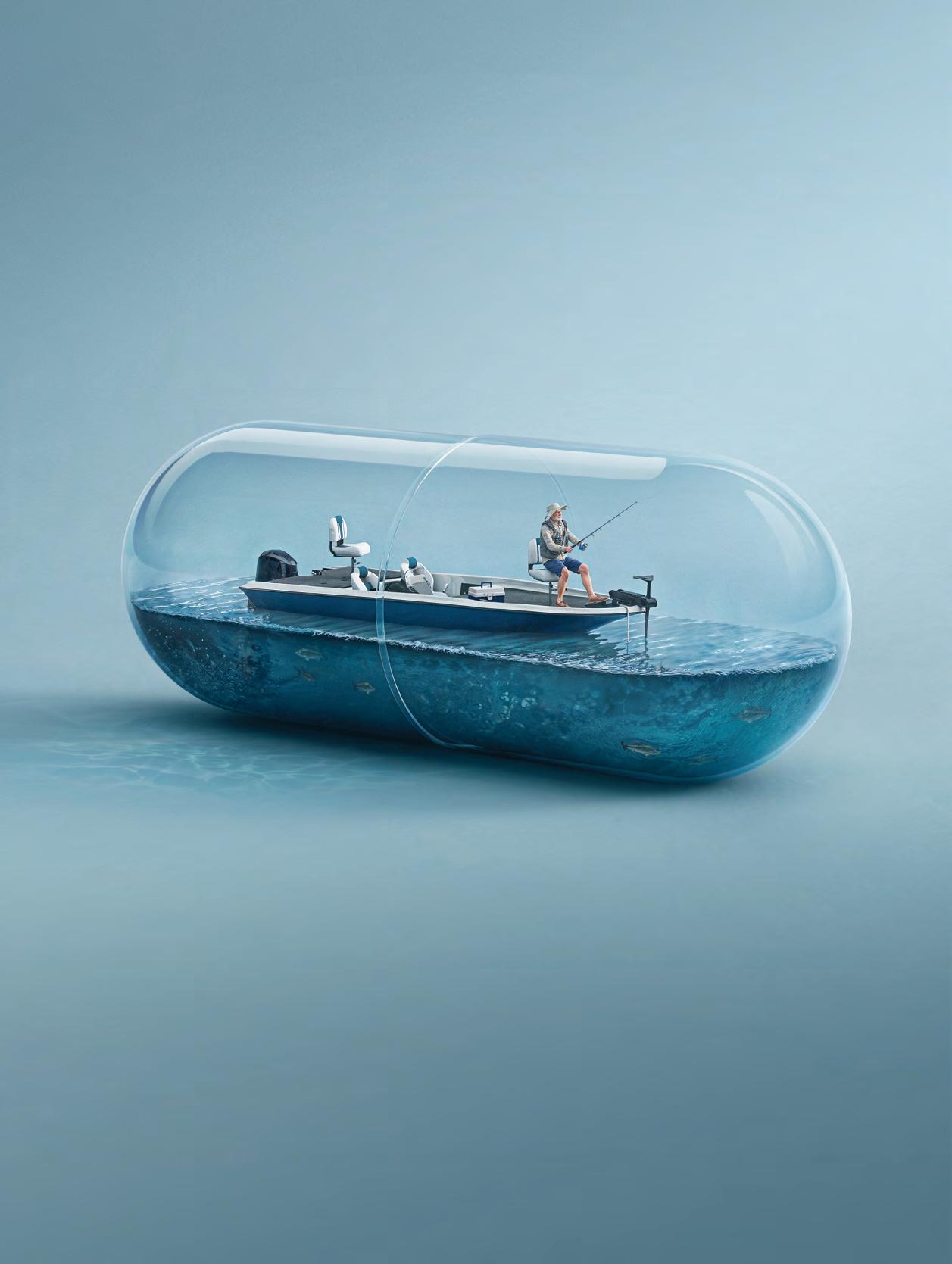
















Tim Barefoot
Since the endangered, gag grouper and American red snapper are o!-limits this month, it would be a good time to go deeper and/or change up your tactics to target di!erent species. For example, go ahead and catch your three scamp/red grouper combo, then switch over to smaller baits and smaller circle hooks on chicken rigs to target beeliners, trigger sh grunts and seabass.
I would strongly suggest taking live pin sh from the marina for scamps and red grouper. is will accomplish two things. One, it will weed out a bunch of trash bites from smaller snappers and other bait steelers because only the sh with a mouth large enough to eat the pin sh will give it a go, and two, it will catch the older (larger) sh that o en will not bite a chicken rig and cut bait. e chicken rig with a bank sinker, and the bank sinker with a triple swivel, leader and hook have been the industry standard for many decades, but these sh have evolved and have become savvy to this method, in my humble opinion. is is the reason the Decoy Jig system is so e!ective. ey’ve never seen anything like it and it’s a clever disguise of what is really happening; the weight and bait are in one clean package, attached by a piece of %uorocarbon.

ere is one downfall to shing live pin sh on the Decoy Jig—it will de nitely get the shark bite. Sharks, like many other sh, are hardwired to eat this struggling bait attached to something else they like to eat, like a squid or a crab.

ere’s another sh I didn’t mention earlier, but this is a good time of year to target hog sh. ere are many schools of thought when it comes to catching them. Many say the chicken rig is the ultimate and, yes, there have been a lot of hog sh caught on your standard chicken rig. But this is a pretty wily species, and hard to catch for a number of reasons. Not only are they hard
to get to bite, but they pull HARD! You have to have seriously strong connections because they will test every part of your tackle. ere’s one more sh that is almost as good table fare and that’s the white jolt head porgy. Same tactics, same everything; you just gotta nd them. ey are beyond delicious. You can troll all you want, but I’ll spend my time bottom shing for the best groceries and keep the light line out back for any wahoo, dolphin, kings or tuna that may cruise by. It pays dividends to jig up live cigar minnows and live sardines on the Sabiki or just purchase them for the light line. August and September are the months that wahoo, yellow n, dolphin, sail sh— you name it—are everywhere inshore following big schools of bait, and a live cig or sardine will de nitely get the bite. I would de nitely keep a live pitch bait ready on a circle hook on piece of %uorocarbon for the sail sh that’ll swim by the boat. Keep the thumping music, cooler slamming loud everything to a minimum if you want to have a shot at getting some of these sh to swim up to the boat. Fact: You’ll see more sh near the boat when you’re quiet, otherwise they will keep their distance and you probably won’t see them, and they’ll have their guard up if they do get near the boat.
Go on, get down to the bottom or at least lower in the water column for the best groceries and keep a pretty live bait out back on the lite line for a great day of catching...not shing.
Check out more from Tim Barefoot at barefootcatsandtackle.com.

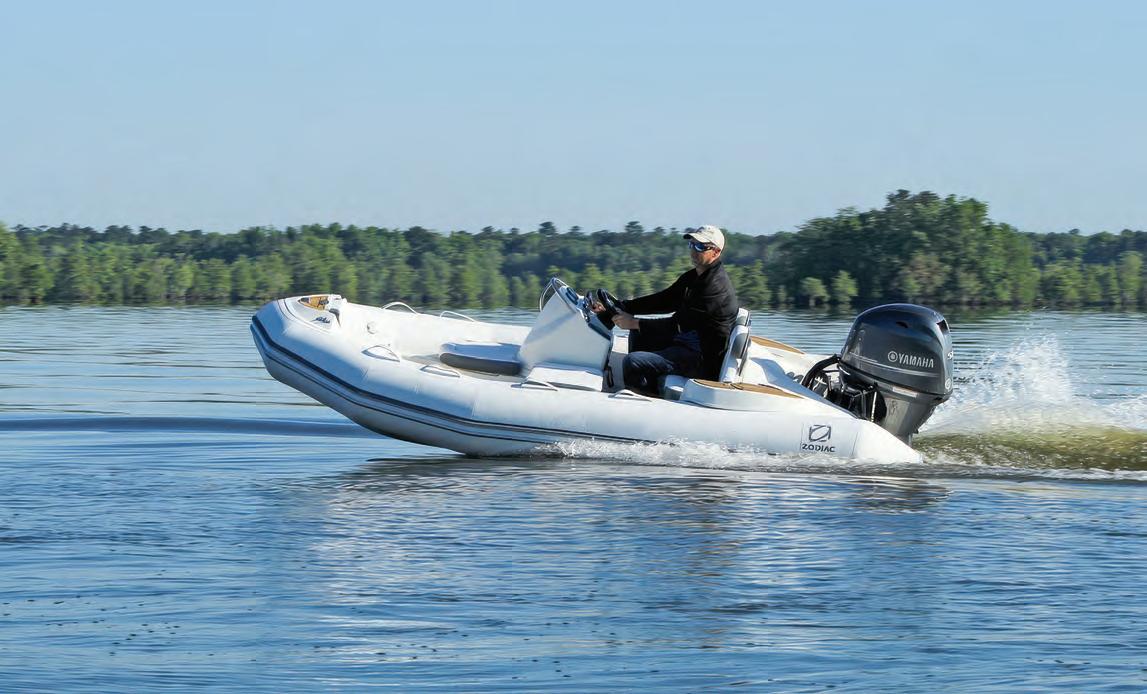
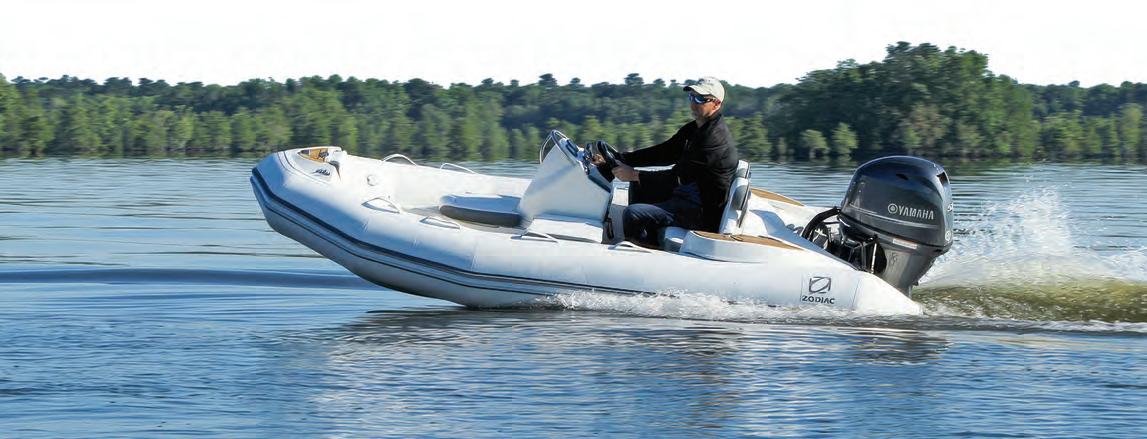


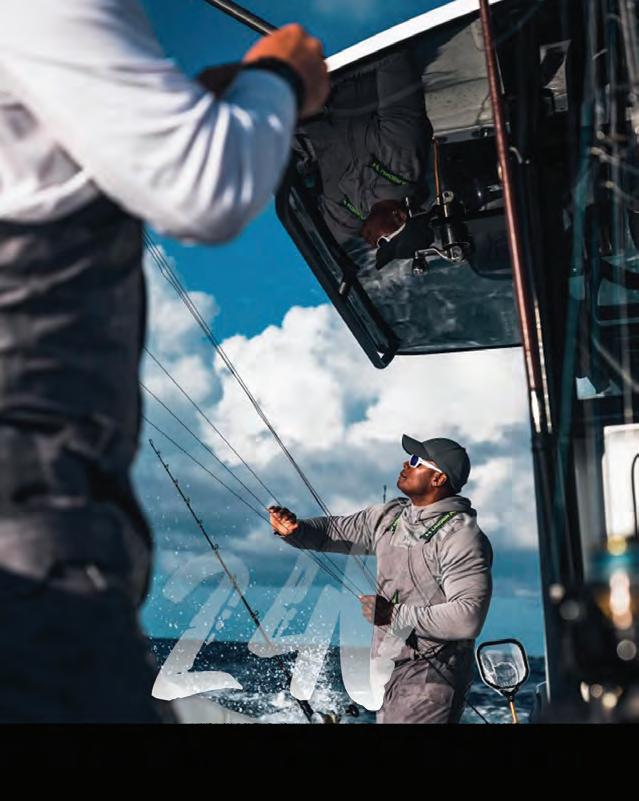










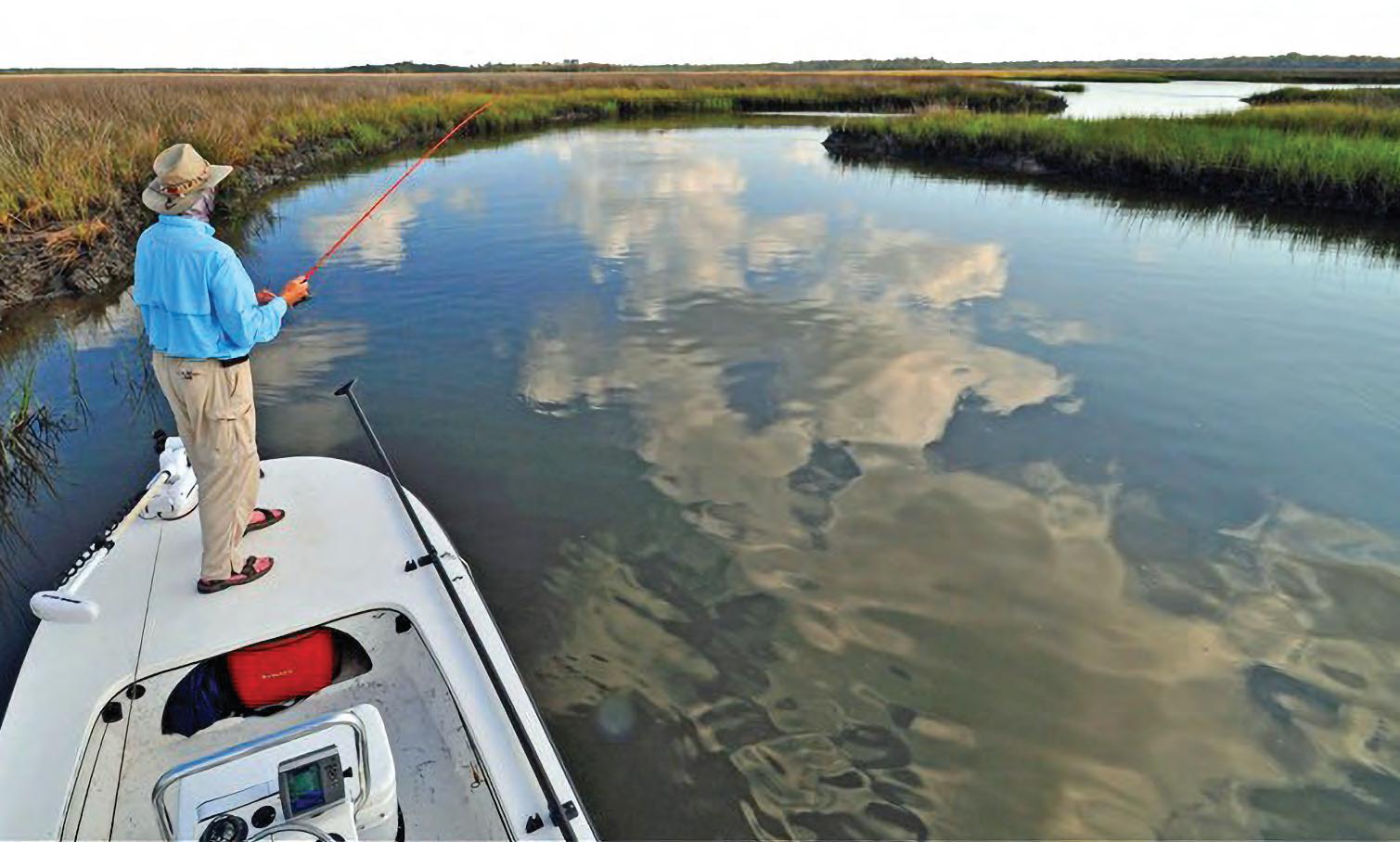
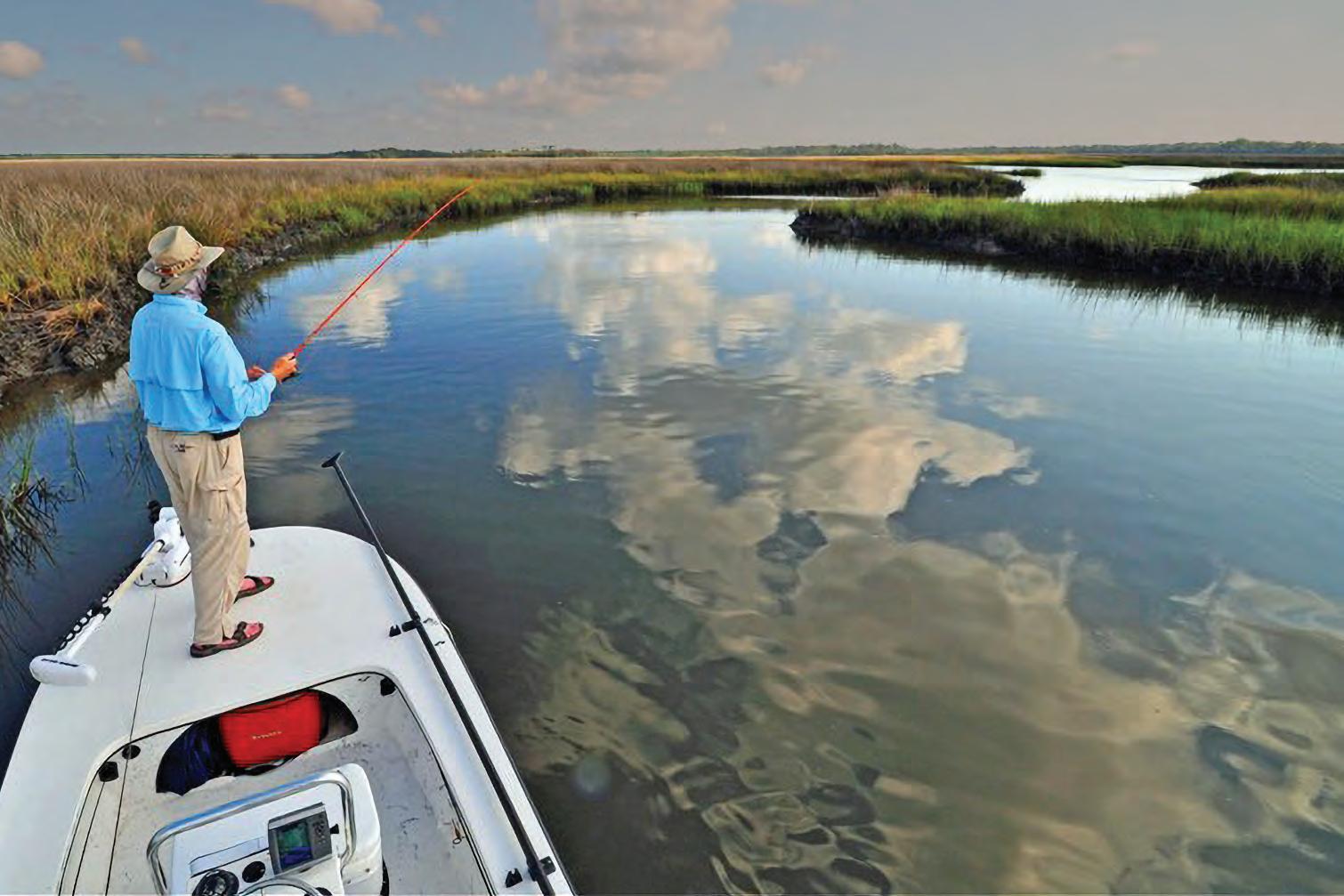
By Joe Woody
Somewhere in McDowell County, North Carolina, where the Blue Ridge Mountains lean in close and the rivers run clear enough to drink, there’s a place where sh outnumber people, and cell service is more suggestion than fact. It’s a land of steep gorges, sparkling lakes, and waters that curl through the woods like they have secrets to keep. Welcome to the triple-threat shing grounds of Lake James, the Linville Gorge, and the Catawba River — tucked into a county that doesn’t make much noise but delivers in trout, bass, and backcountry beauty.
If you’ve never heard of McDowell County, don’t worry — that just means the sh haven’t heard of you either, and your odds are still good. Whether you’re a dry-%y purist with a hip pack and a “River Runs rough It” complex or someone who likes to toss worms near pretty rocks, this corner of the Carolinas has a spot for you. Bass are stout and sassy. Trout are plentiful, and they have attitudes to match. So gas up the truck, tie on something that worked last season, and head for the hills. e shing is great, the views are even better, and McDowell County is ready to welcome you — even if the trout aren’t.
Lake James is the area’s big-water bu!et. is 6,800-acre reservoir between Burke and McDowell counties o!ers smallmouth and largemouth bass, walleye, crappie, bluegill, hybrid striped bass, and cat sh. Spring and early summer bring aggressive smallmouth to the surface from April to June. Tossing a Pop R or a Zara Spook at dawn can trigger explosive strikes. Crappie move shallow in May and June, while cat sh linger year-round, especially from fall through early spring. Bass shing is best around rocky points and submerged trees with crankbaits or so plastics. Walleye respond to trolling or jigging near the dam. If you’re a er cat sh, bring cut bait and patience. Lake James State Park has public ramps, campgrounds, showers, and picnic shelters — perfect for anglers who like their wild with a touch of comfort.
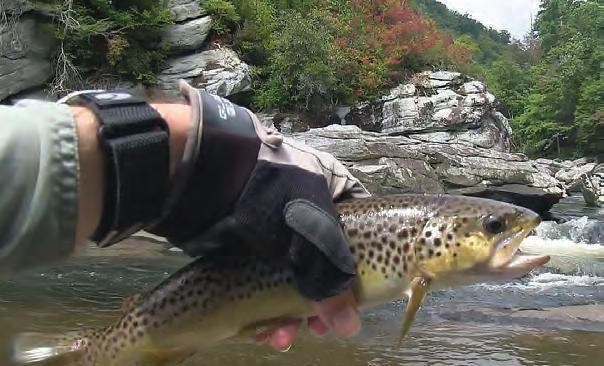
If Lake James is your comfy recliner, Linville Gorge is the rugged Adirondack chair that bites back. Known as the Grand Canyon of the East, this steep gorge is home to the Linville River, one of North Carolina’s best wild trout waters. e upper river holds wild and stocked rainbow, brook, and brown trout. Below Linville Falls, you’ll nd a backcountry adventure with native browns lurking in clear pools. Reaching prime spots requires steep descents, with some trails dropping 1,400 feet. e solitude and scenery reward every blister. Bring light tackle, stealthy casts, and plenty of water. Spring hatches bring trout to the surface, and a well-placed dry %y can tempt a wary sh. Remember your headlamp — climbing out in the dark is no fun.
Below Lake James, the Catawba River %ows cool and clear, sheltering rainbow and brown trout that grow large and wary. Float trips are ideal. An eight-mile dri from Bridgewater Dam to Morganton delivers ri sh. e Joseph McDowell Greenway o!ers piers, canoe launches, and bank access perfect for beginners or families. Streamers and weighted nymphs excel in the tailwaters, while warmer sections downstream attract bass and pan sh.
Wherever you cast, the sh here don’t come easy — but they come honest. And in this corner of the Blue Ridge, that’s the best kind of bite.






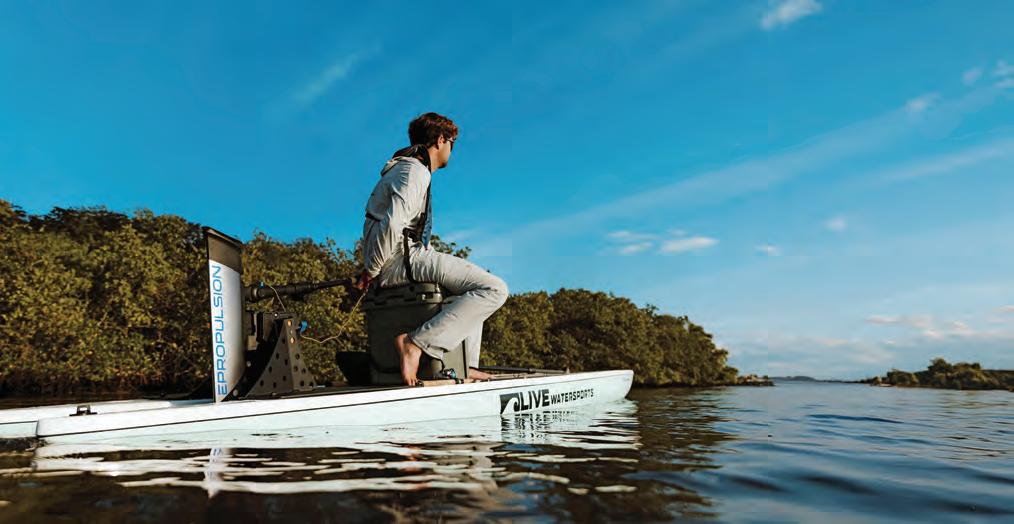












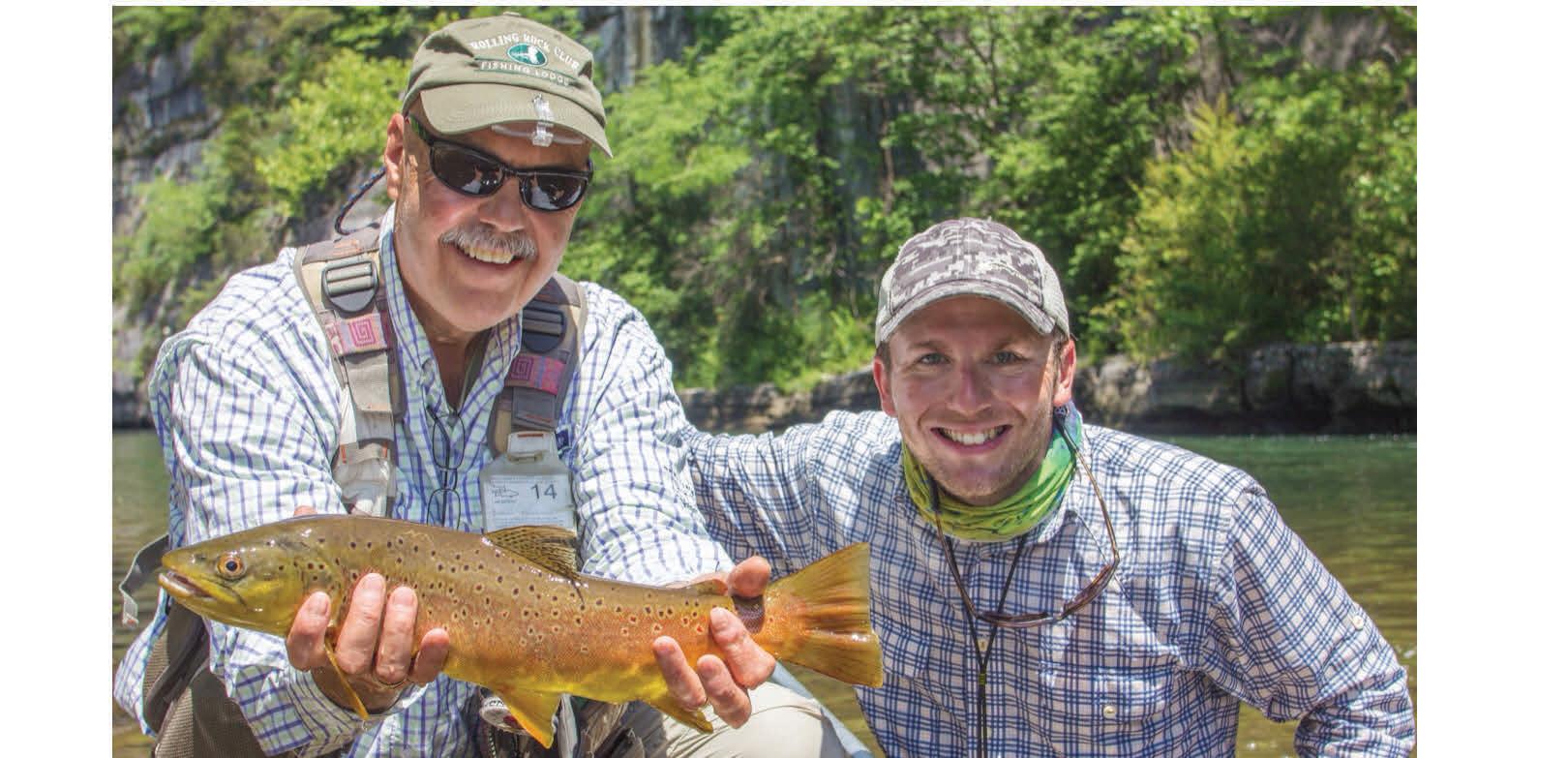




Capt. Mike Smith

Black drums, aka “Big Uglies,” are a super fun sh to catch. It doesn’t matter if they are 18 inches weighing two pounds or 5 footers weighing 90 pounds. ey put up one heck of a dragpulling ght once they gure out that they’re hooked.
Black drum can be found in inlets, saltwater estuaries, bays, river mouths, brackish creeks and especially anywhere in close proximity to oyster beds as they love to eat oysters, clams, crabs, shrimp and bait sh. ey are o en in huge schools and will stay in one spot for a week or so if there is a lot of food for them and not a lot of predators, which means that you can catch dozens of them when the bite is on.
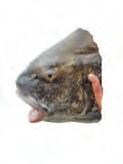
My favorite way to target “big uglies” is on the incoming tide, in shallow estuaries, less than 3 feet deep. at is when you can see them tailing as they root around oyster clumps for crabs and shrimp. A well-placed shrimp or crab o!ering will get their attention very quickly. Make sure you have enough weight to get it to the bottom so they can nd it.
on them. De nitely sh the older docks with the most stu! growing on them. ese docks pilings will attract the most crabs and shrimp to them. Old dock pilings are like grocery stores for black drum. When I sh the docks for black drum I usually have one of two baits with me. Live or frozen shrimp or a scented shrimp jig. ose are my goto baits for drum around the docks. Real shrimp works the best, but the scented jigs are pretty good too. A shrimp rigged with a small split shot is how I usually target black drum. Just cast it to where you think the sh are and wait for the hit. If you are shing with a scented shrimp jig just bounce it slowly on the bottom as you reel it in. It is similar to the way that you would sh for a %ounder. e slower the better.
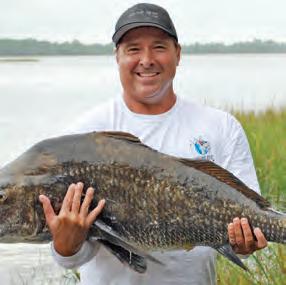
Black drums have four nostrils, and their sense of smell is amazing, so the stinkier the bait, the better when targeting these sh. A great arti cial bait is the Berkely Gulp shrimp on a 1/8 ounce jig head. You can just cast it to the sh and let it sit on the bottom and wait for them to nd it. However, if you give it a bounce or two you will usually get their attention much more quickly.
Another great place to target “big uglies” is around docks. Dock pilings tend to have lots of oysters, clams, barnacles and sponges growing
For surf shing anglers, large schools of black drum typically work their way up and down the beaches in the cooler months feeding on crustaceans. Use a beefed up pompano rig, jig or sh nder rig and place them in front of the schools approaching. Long casts are o en needed, so be sure to have plenty of line capacity on your surf shing reels when targeting the large ones. Not to mention, once you hook into a big drum the drag is going to go screaming! You’ll want anywhere from 20-50 lb. main line for your best opportunity to land one.


Black drum make for a tasty dinnertime treat, but I wouldn’t suggest eating the big ones. ey are always full of worms. I nd that the best ones for eating are 28 inches or less in length.
I caught the black drum in the picture above on a dead shrimp. It was about a 50 pounder and took 30 minutes to get it in. I saw it tailing next to an oyster bar.
Capt. Mike Smith, owner of Fish Your Ass O Charters, is an inshore shing guide who has been shing the inshore waters, oyster bars and grass ats of Florida for more than 40 years. Reach him at (561) 339-2317, email: contact@ shyourasso .com or visit shyourasso .com.
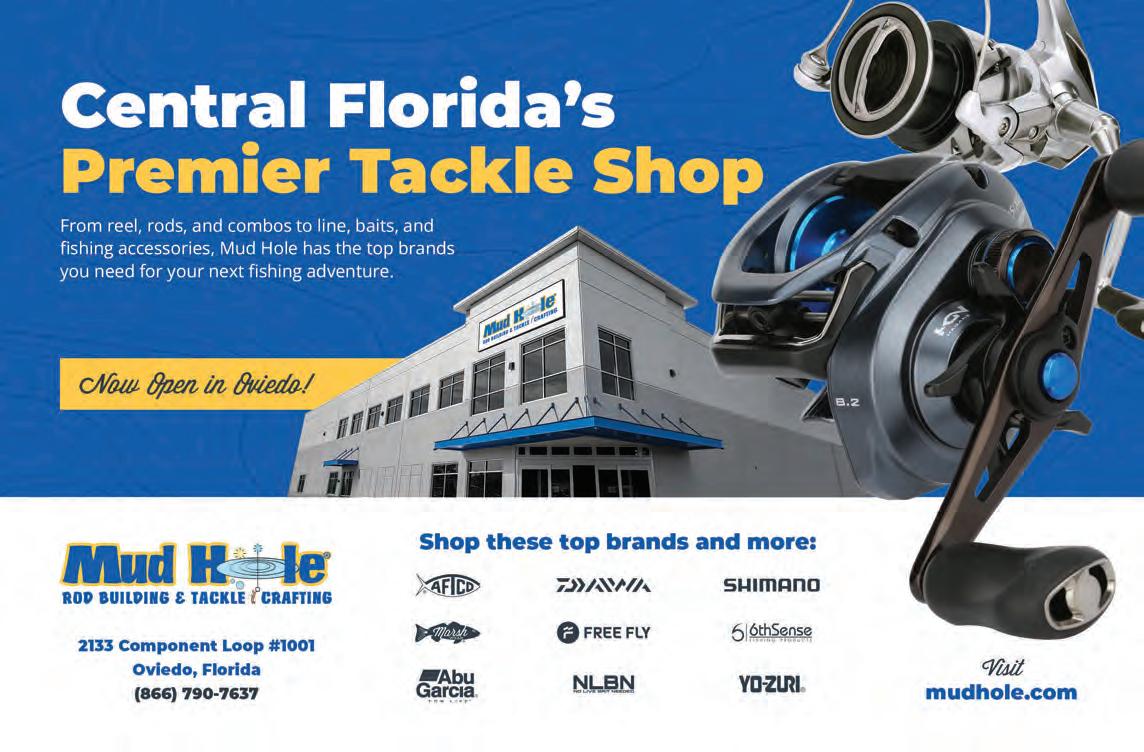

By A. deGruchy
Late spring into early summer is prime time for permit in Islamorada. !ese sh are picky, powerful, and love crabs, so having the right gear and approach can make all the di erence in getting one to the boat.
A 7’ to 7’6” medium-heavy spinning rod with a fast action provides the backbone needed to handle their long runs and sudden bursts of speed. Pair that with a high-quality reel in the 4000–5000 size range, spooled with 20–30 lb braid for better sensitivity and hook-setting power. Personally, my go-to is the Fenwick Inshore Elite rod paired with a 4500 PENN Authority reel. Since permit are known for being line-shy, uoro leaders are a must. 20 lb leader is ideal along with a 2/0 circle hook to increase the chances of a solid hookup. We rely on the Mustad Demon inline circle hooks and they’ve never let us down.
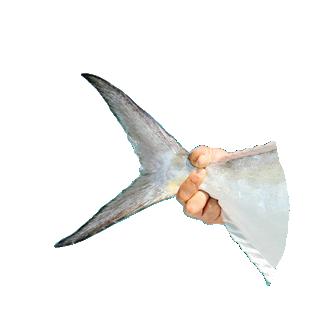
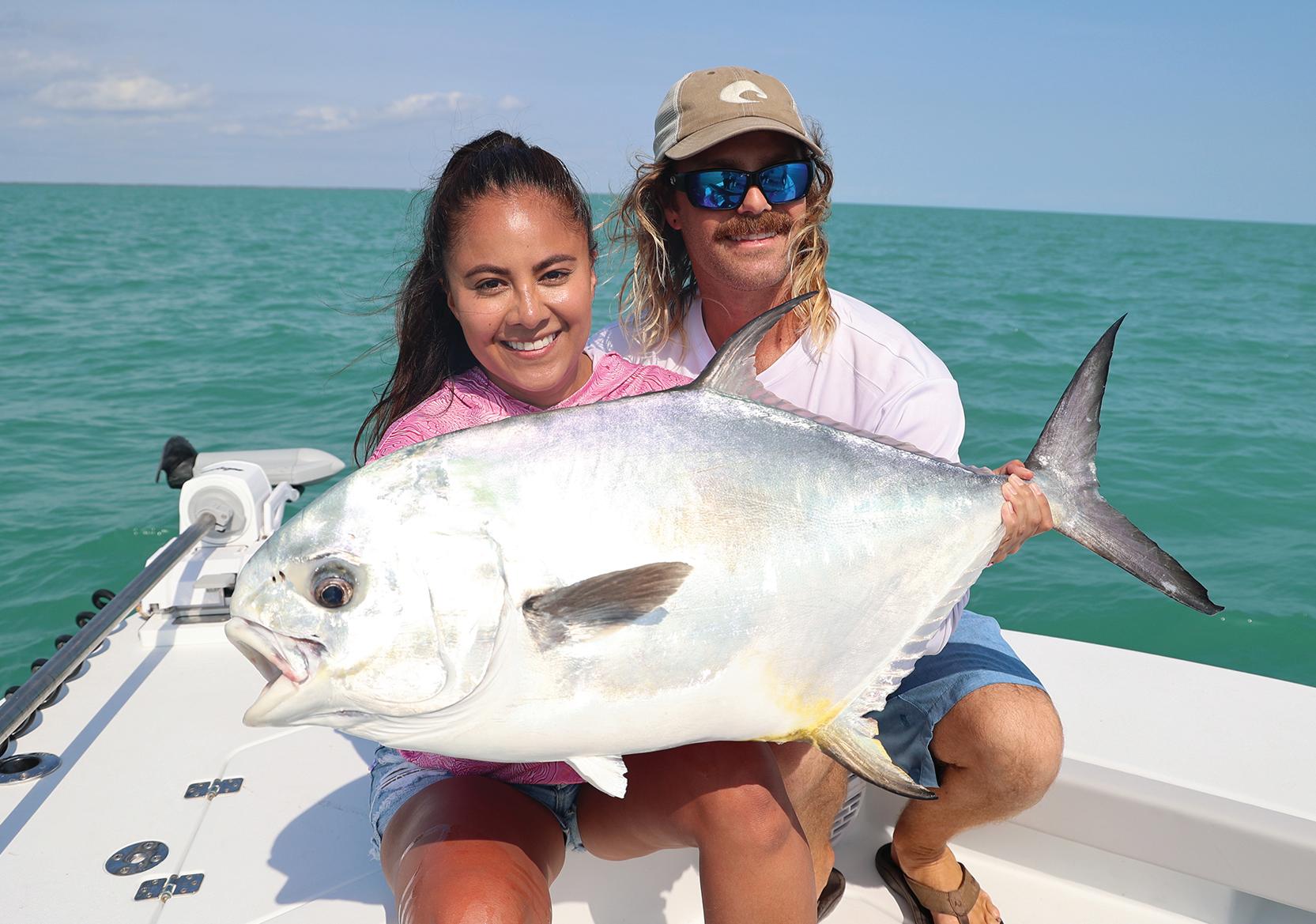
Finding permit in Islamorada means knowing where and when to look. Flats and channels are
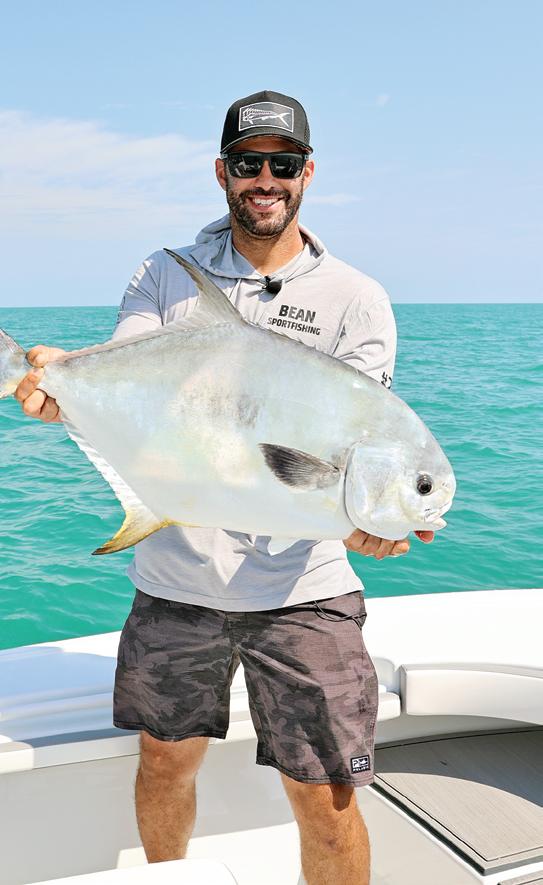
the best spots, as well as some public wrecks. Watch for sh tailing in shallow water or cruising deeper cuts, or schools of permit circling wrecks. A moving tide, whether incoming or outgoing, stirs up crabs and gets permit feeding. When presenting bait, it’s important to cast ahead of where the Permit are heading, let the crab sink naturally, and maintain light tension.
Patience and stealth go a long way when targeting these sh. If a permit is spotted, it’s best not to rush. A smooth cast, a natural bait presentation, and a little patience can make all the di erence. Once hooked, steady pressure and a good drag system will help handle their powerful runs. May and June in Islamorada o er some of the best permit shing of the year. If you’re ready to chase permit in Islamorada, book your trip now at www. beansport shing.com, spots are limited!
Be sure to follow deGruchy’s adventures at @bean_sport shing on Instagram and YouTube.



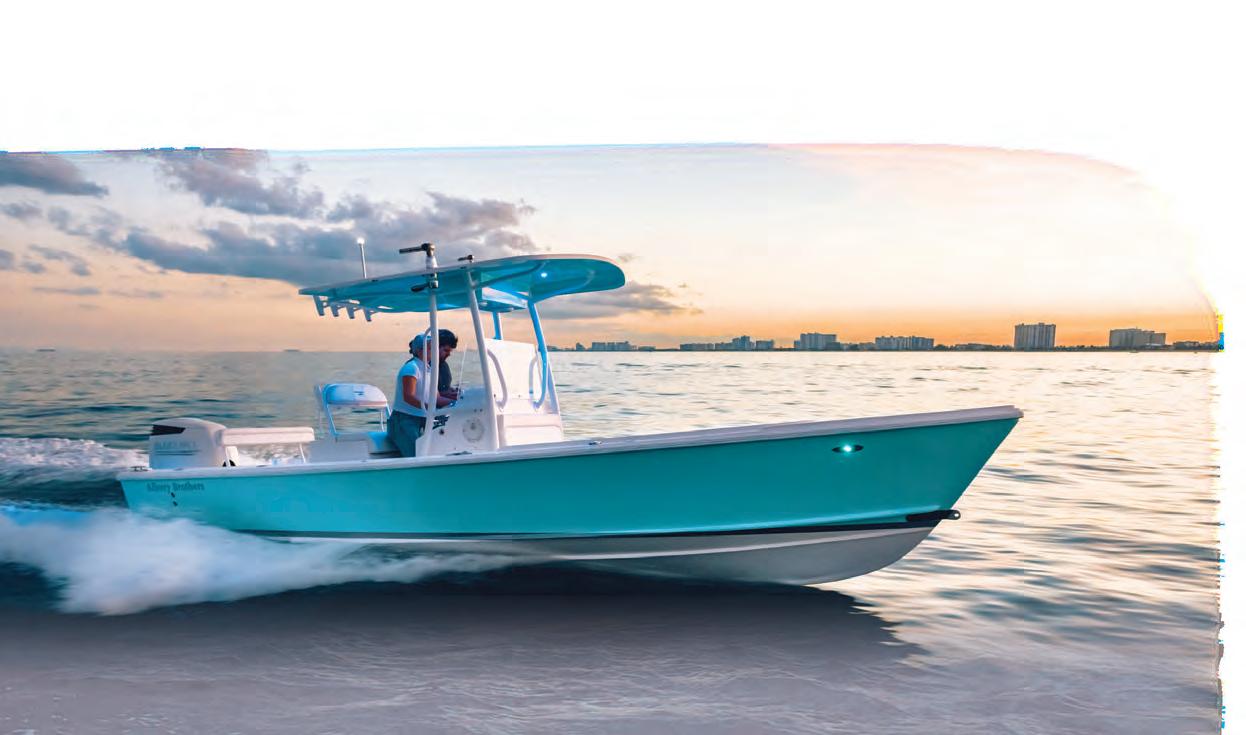

Stationed strategically around the East Coast, all Suzuki RePower Centers have achieved the highest level of Suzuki certifcations to meet and exceed your repower needs. Mastry Engine Center has received the Suzuki Marine Super Service Award and has been ranked #1 in Suzuki Marine US Sales! 60 YEARS OF REPOWER EXPERIENCE!

RePower Packages designed to best ft your needs and not stretch your budget. Financing available.

Rest assured, all Mastry Suzuki RePowers are backed by Suzuki’s industry leading 5-year or 7-year factory warranty.
When Considering A Repower, Consider These Factors:
•Every Authorized Mastry Suzuki RePower Center has decades of repower experience providing proper rigging, controls, propeller matching and in water testing
•With a Mastry Suzuki RePower, owners gain improved performance, less noise and greater reliability
•Mastry Suzuki RePower’s exclusive Owner’s Edge Program*
•Mastry Suzuki RePower Centers use authentic Suzuki OEM parts and have factory certifed technicians


Since 2014, Mastry Engine Center, has been building the premiere Suzuki Outboard repower network in Florida. Today, Authorized Mastry Suzuki Outboard Centers have been exceeding expectaions in the Southeast for over two decades. Recently Suzuki Marine requested Mastry Engine Center to expand the network throughout the Northeast. Now boat owners from Maine to Florida can be assured of the best support for their Suzuki outboard repower project. All Authorized Mastry Suzuki RePower Centers provide the best options, information and package pricing for excellent performance in repower.




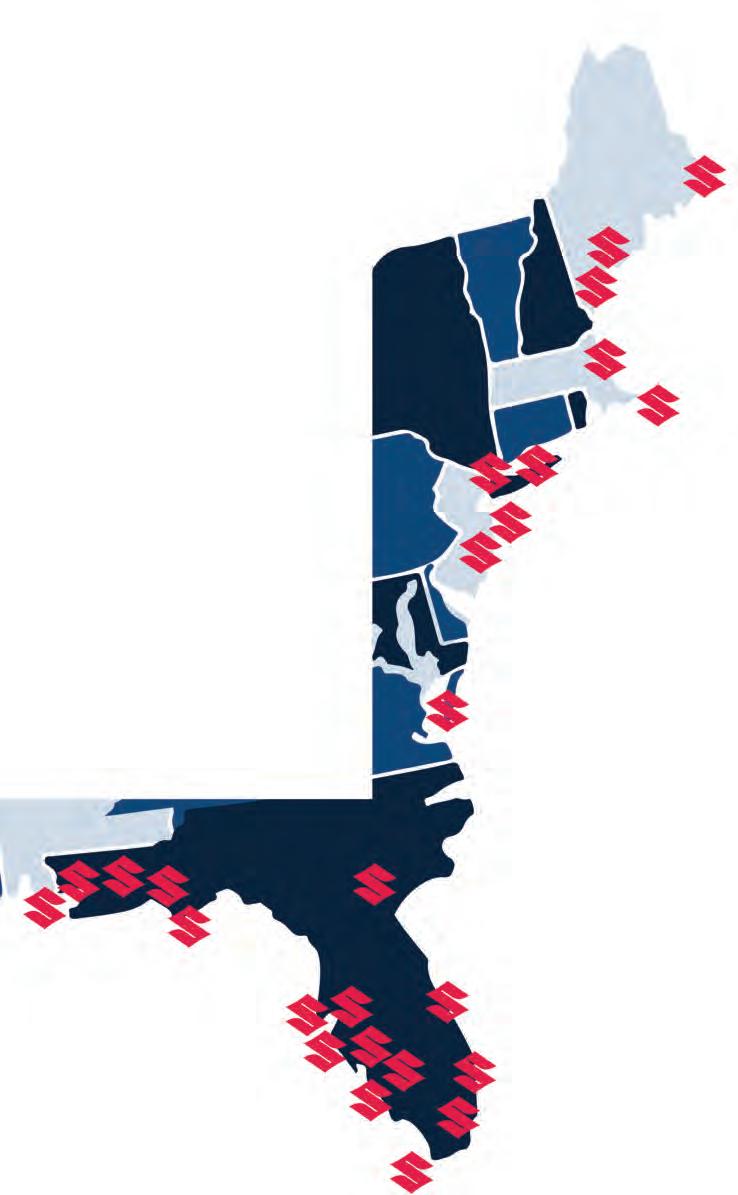

*Get with the Program!
When you purchase a new Suzuki outboard from an authorized Mastry RePower Center you qualify to become a member of the Mastry Suzuki Owner’s Edge. Owners receive an identifcation card that provides them with important information about their Suzuki outboard motor as well as a passport to additional benefts during ownership. Members enjoy a detailed engine maintenance schedule, Mastry Suzuki RePower Trade Program and special pricing from Mastry Suzuki Partners.
When summer rolls around and the tides align, there’s no place I’d rather be than Southwest Florida—with a rod in hand and visions of giant snook dancing in my head. !is year, my buddies and I made the pilgrimage with a simple mission: land a personal best. Big sh only. No compromises.
Dawn Patrol: First Cast, First Heartbreak
Our daily rhythm was dialed in: sh at rst light, break for lunch and a nap, then hit the water again at dusk. On our rst morning, we were thighdeep before sunrise, casting into the mystery of the early light. Within minutes, I hooked a brute. It crushed my lure and made a blistering run—until my line snapped clean. Devastated, but not alone; the others were tight on steady 20–25 inchers. We spot-hopped the rest of the morning, landing a solid variety of sh, then rested up, ready to tangle with giants again at dusk.
Evening Drama: Three Strikes !at evening, we waded into a legendary snook haunt. I connected again—with something even bigger. A er a long, nerve-wracking battle, my
leader snapped. Again. Moments later, John hooked into a monster that nearly emptied his spool… and then his leader failed too. We were stunned but red up. !e big girls were here.
I re-rigged and kept casting. Soon enough, another explosion on my paddle tail—this one the biggest yet. She breached once, massive and thick. !en, just like that, gone. My third heartbreak of the day. Lesson learned: if you’re chasing giants, bring the heavy gear.
Turning the Tide
By Capt. Michael Okruhlik

massive strike. !e sh peeled line o like a runaway train, then turned and charged. I cranked fast, heart in my throat. !e ght was clean, intense and unforgettable.
Day two brought redemption. Je landed his personal best—an impressive 34-inch snook on a 4” Knockin Tail Lure. I was eager to return to the spot that broke us, but a sudden evening storm shut us down.
Final Shot, Forever Fish
Our last morning o ered solid action—snook to 8 pounds, nothing to complain about. Still, I couldn’t shake the thought of one last chance that evening. No storms. No wind. Just at, silent water and that nal opportunity.
She measured a fat 38 inches, bottoming out my 15-pound scale. Hooked right in the jaw, leader untouched. My new personal best.
The Verdict
!is trip was a rollercoaster—equal parts frustration and triumph. But that nal evening, under a fading Florida sun, everything came together. And that’s what keeps us coming back: one cast away from glory.
Capt. Michael Okruhlik is the inventor of Knockin Tail Lures®, and the owner of www.MyCoastOutdoors.com.
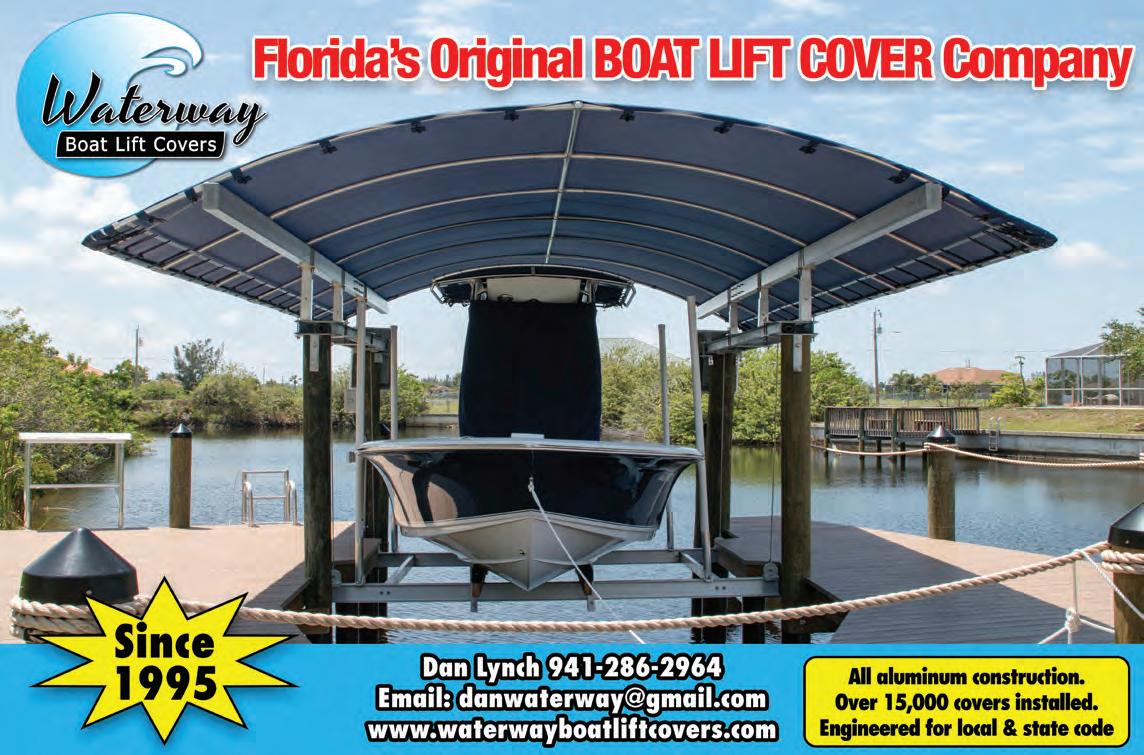
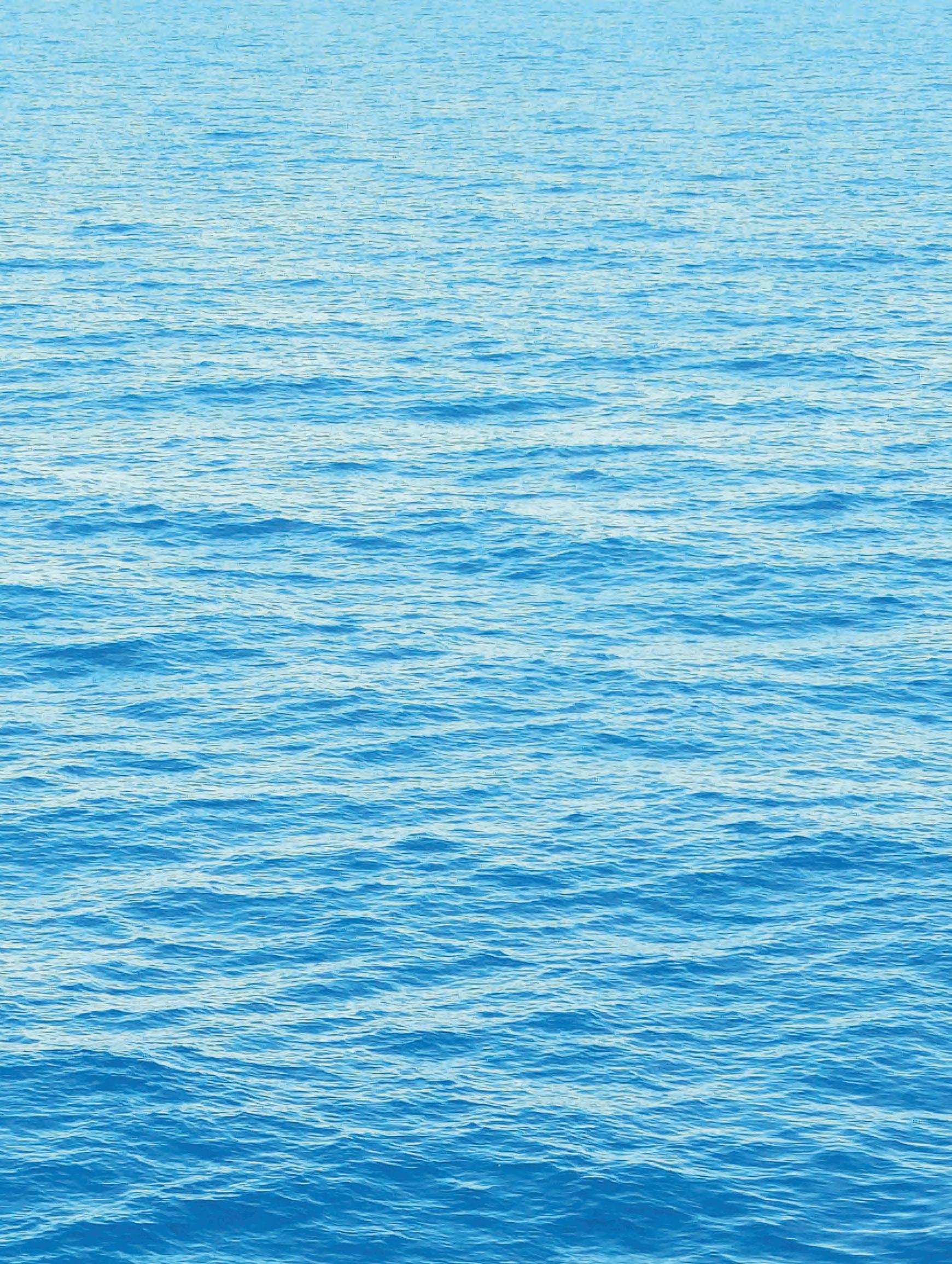

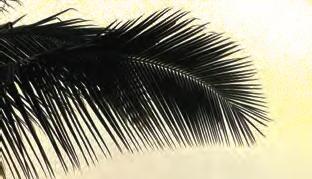

outdoors enthusiasts in Indian River, St. Lucie and Martin counties.

By
Europeans came to Florida seeking wealth and resources. Since first contact entrepreneurs have sought profit from the sparse resources of the frontier that was La Florida. Florida / Bimini has always represented a romantic illusion of fantastic wealth and easy living. Florida’s natural resources proved to be either mythical or rather difficult to extract.
It’s likely that Florida was “discovered” by slave catchers. The Hildalgos that followed were seeking treasure, fame and evangelism. Florida’s coastline presented a strategic danger zone that challenged conquest. The flora, fauna and people of the New World had a different ecological experience than the newcomers. The indigenous residents didn’t have the sophisticated immune response mechanisms to defend their health and culture from the exotic Spanish invasion some 500 years ago.
The old-world colonization of the new world was undertaken with avarice, coercion, exploitation and pestilence. Floridians were particularly vulnerable to this invasion. The new-world and the old-world had different ecological experiences and had evolved separate sophisticated biological immune response mechanisms, cultures and cosmology. Many newcomer versus old-timer conflicts still arise in Florida today. the status quo has become short indeed.
Many individuals have varied opinions about how common
resources: water, air or wilderness, should be shared or owned. The tragedy of the commons (when too many use a limited resource) is compounded by the American
but has become a juggernaut in the last 100 years. Industrialized agriculture, urban development and transportation infrastructure have terraformed the land and altered the course of water. Natural ecosystems struggle in diminished and impounded form against a huge population increase with its attendant pollution, waste and exotic invasive competition. Environmentalists and scientists have won a few battles. We do have some wonderful parks and marine protected areas. There are some wildlife corridors and “natural wonder” tourist attractions. The impediments to Florida’s total exploitation are falling away. We are losing protections for nature at an alarming pace. The battle to save

and we are building an immigrant internment camp on sacred lands in the Everglades. Climate change should be treated as the existential threat to humanity that it is. But we tend to be inherently content to be comfortable and complacent with a penchant for absorbing selfaffirming ideologies.
There are certainly times that protest is performative. Activism can be myopic. And advocacy is sometimes self-centered. There are legal and economic limitations on what environmental not-for-profits can do to raise awareness and sway the public inertia. But the future is on fire. We must realize that science is under attack, morality is disregarded, and life has become

perception of ownership and property rights (where resources are commoditized). We have effectively segmented our wild places, drained our wetlands and diminished their natural productivity while deregulating our impacts and imposing a transactional relationship to the land. The stakes for environmental protections are higher than ever.
The destruction of Florida’s fragile ecosystems has happened in fits and starts since “discovery”
the state parks from landscaped recreational amenities took a shameful amount of energy. There are proposals to allow bottom trawling in Florida’s oldest deep coral reef marine protected area. We suffer fishkills and algae blooms, while we propose to spend less money on remediation. Legislation will allow off-site mitigation banking for damaged wetlands and mangrove destruction. We are allowing a rock mine to undercut the publicly funded EAA Reservoir,
transactional, most new regulations are being designed for corporate profit. There may be moral, ethical and ideological paradoxes, the fixes may challenge us economically and culturally. First, we must change course politically, nationally locally and in our State Capital.
To learn more about the benefits of supporting Indian Riverkeeper, email Exec. Director Jim Moir at IndianRiverKeeperFL@gmail.com or call (772) 341-4953.

Capt. Terry Wildey
Big Easy Fishing Charters (772) 538 - 1072 www.bigeasyfishingcharters.com captwildey@bellsouth.net
Warm,clear water usually makes for tough, slow fishing in August, this combined with the impact of the extra 150 plus boats a day during the red snapper opening for two days this season it will surely have an impact on the bottom fishing that might last into August. I’d much rather see them open it to one per boat per day until the quota is reached.
If we get a thermocline that pushes fish into our area from the deep and southern water, such as mutton snapper on the beach reefs 20 feet to 45 feet and amberjack on the 85-to-90-foot reefs, it will be something to look forward to.
Kingfish, some in the 40# to 50# class, will be our only sure thing. Start looking around the bait pods that pop up from just outside the inlet and sometimes 3 to 4 miles out. You’ll often catch the kings right where you’re catching your threadfins. You have to figure the reason the bait is on the surface is because there’s predators underneath. Also, the artificial reefs will hold bait, cobia and mangroves.
for tile fishing and you don’t have an arm, like a wrestler, you might want to invest in an electric reel. The Diawa Tanacom 1000 is a good start. Pair that with some 80# PowerPro on a 50 to 80 Bent Butt Rod and you’re set up for deep dropping. You’ll find it satisfying to have something else to try when you’ve trolled to 600 feet without a knock down. If there’s one thing to look forward to in August, it’s some calm water and sunny days. Throw a few extra bottles of water on the boat and stay hydrated. And watch out for those 3 p.m. storms. Always plan to go early and be in early. Early bird catches the worm in August, but it’s the second mouse that gets the cheese. That means it’s a good time to try some night fishing. Especially around the full moon.
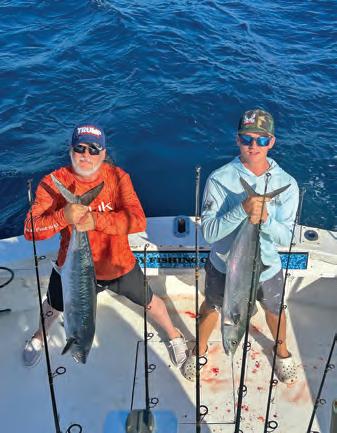
The trolling offshore is usually quiet in August so if you do go deep, make sure you’re prepared to drop to the bottom to salvage your day. It’s a good time for some tile fishing. They’re usually in 680-to-740-foot depth. If you’re looking to set up
Despite what some might say we do have good fishing in August. Let’s all pray the hurricanes stay away. As always be kind to your fellow anglers, you might need a tow one day. Fish on, gotta go!







Capt. Gus Brugger
Pattern Setter Charters (772) 360-6787
www.WelcomeToSebastian.com
SEBASTIAN RIVER – The north fork of the Sebastian River will still have tarpon rolling in the early morning and evening, especially after thunderstorms cool the surface waters. Flies, plugs, D.O.A. TerrorEyz and finger mullet will all catch these backwater tarpon. The docks and bridges of the lower river will be good places to work jigs, plugs and D.O.A. shrimp both day and night for snook.
– Fishing plugs, jerk baits and D.O.A. shrimp around the shoreline cover will draw strikes from snook of all sizes. Seatrouts have appeared in decent numbers on the patchy grassbeds that have finally, after more than a decade, begun to re-establish themselves. Covering ground with topwater plugs or jerk baits is a good way to catch trout and redfish on the flats. Mosquito impoundment culvert
outflows and residential canals are excellent places to look for juvenile tarpon and snook in August.
SEBASTIAN INLET – August is always a great month to catch and release snook and oversized redfish at Sebastian Inlet. Fishing outgoing tides with live baits including croakers, pigfish, greenies, pinfish and shrimp will be the key to daytime snook action. Night fishing can also be great, whether you drift through the bridge with live bait, or cast plugs, bucktails or soft plastic swimbaits from the rocks. Bull reds will take advantage of the buffet provided by the inlets outgoing tides. They can be caught in the same areas and on the same baits as snook, but when juvenile crabs decide to catch a ride on the outgoing tide, big reds and permits can often be seen slurping them off the surface along the rip created by the outgoing tide as it pushes into the ocean. Topwater plugs, poppers, crab flies and live crabs properly placed will do the trick.
should find king mackerel, bonito, and the occasional cobia within a few miles of the beach as long as the ocean
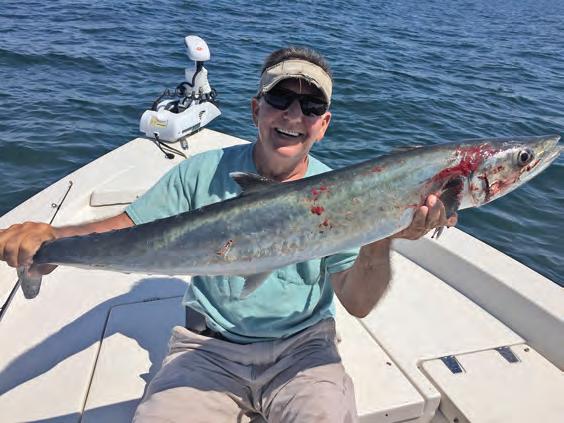
remains calm and clean. Slow trolling live mullets or greenies around bait pods or hard bottom structure in 30-to-45 feet of water can be exciting and productive. As mullet and other baitfish begin their southern trek late in the month, the fishing along the beaches should really heat up. Big tarpon, kings, Spanish mackerel,
sharks, snook, jacks, etc. all follow the bait south. The mullet schools generally travel within casting distance of the beach, giving anglers a great opportunity to catch a truly big fish from the surf.
The early bird gets the worm, especially in August.
Tight lines!
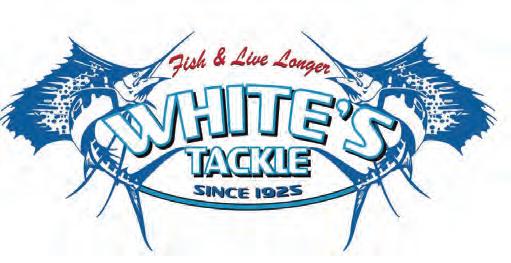

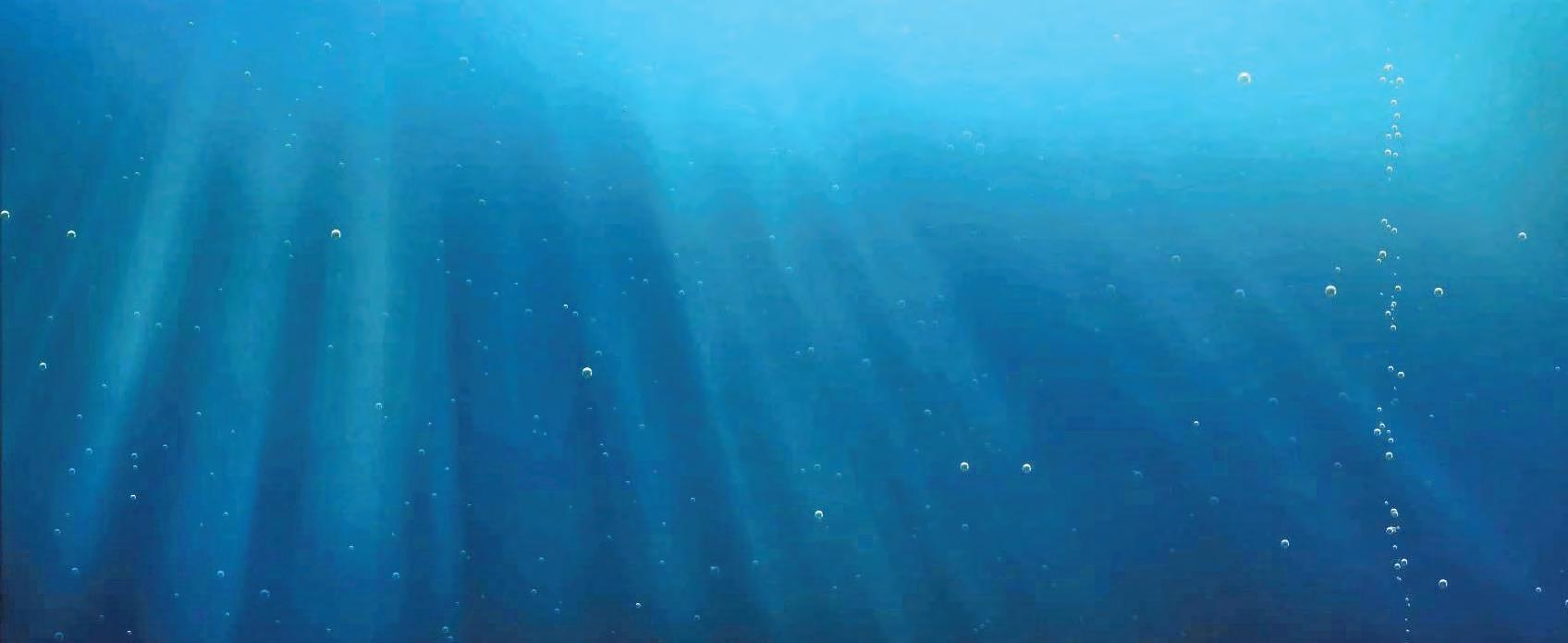
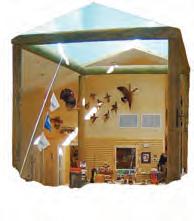

Capt. Scott Fawcett
Off the Chain Fishing Charters (772) 285-1055
offthechainfishing.com fishscottyf@bellsouth.net
The smoke has cleared from the fireworks, but the Treasure Coast fishing is still poppin’! Historically August was never a banner month but in the last 8 or 10 years it has consistently provided some really good action. Sailfish, tuna, wahoo, kings, bonito and mahi take up full time residence on the Treasure Coast and although waters are typically pushing 90-degrees out in the stream this time of year, when you get in the cooler sections of water outside of it, fishing can be very productive.
Live bait is typically my method this time of year, although if I was strictly targeting wahoo or dolphin I would probably troll. Most fishing takes place shallower than 350
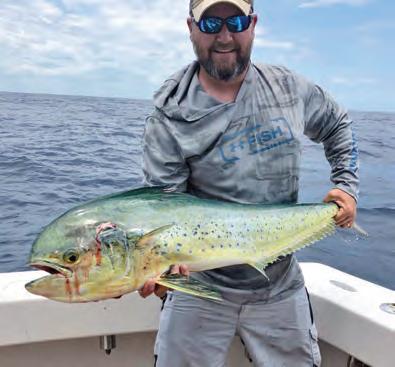
feet right now, except for going for yellowfin tuna and swordfish with the water being so hot.
This is the perfect time of year to fish a down bait on a downrigger or try fishing a vertical jig while you’re live baiting. We use a Cannon 10 TS optimum downrigger because it has a cycle mode which often triggers lazy fish into biting and doubles as a dredge boom later in the year.
Whatever style of fishing you decide to do this August, I hope your next trip is Off The Chain! Please give me a call if you have any questions or if you would like to reserve a day out on the water.

Sea Tow is happy to extend it’s service to include tows from Nothern Bahamas, Green Turtle, West End Marsh Harbour, Hope Town and Grand Cay to the U.S.
Whether you need a timely tow or help offshore, Sea Tow Captains are standing by 24/7.
Why wait? Join today and get 2 months free! (That’s a $28 value!) Use discount code: TCT.
Join Sea Tow Treasure Coast \ 772-225-3144 800-4-SEATOW
seatow.com/local/treasurecoast
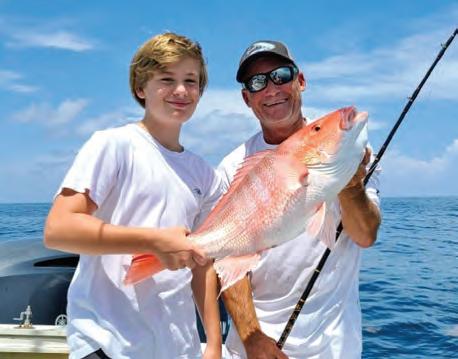
Sailfish, tuna, wahoo, kings, bonito and mahi take up full time residence on the Treasure Coast and can be caught when you get in the cooler sections of water outside of the stream.

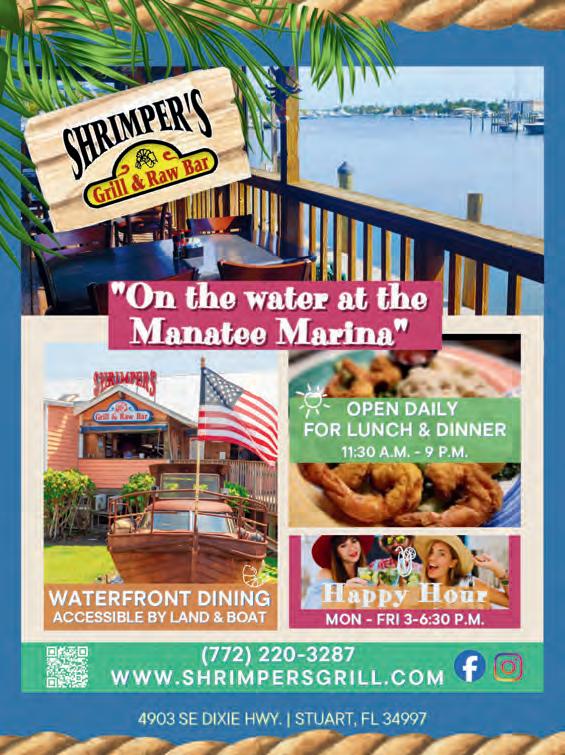
Safari I Deep Sea Fishing
Pirates Cove Resort and Marina 4307 SE Bayview St. Port Salerno Reservations: (772) 334-4411 www.safari1deepseafishing.com
Snapper and grouper fishing will be the go-to strategy for near coastal anglers during the hot summer days of August.
Several local species of snapper, including lane, vermilion, mangrove (gray), and mutton will be solidly into their yearly spawning period this month. These snapper family members will populate an expansive swath of Martin County’s reef system from 50 to 180 feet of water, allowing captains and anglers to dial in a daily fishing strategy that best suits individual tastes and abilities.
Depths of 55 to 95 feet of water will be the focal point for most snapper fishing and will allow anglers to catch representatives from all four
Capt. Jonathan Earhart
Chaos Fishing Charters (772) 341 – 2274 www.chaosfishingcharters.com jon@chaosfishingcharters.com
Summer fishing patterns are in full effect as we would expect for the month of August here on the Treasure Coast. Early morning and late afternoon fishing will be best to avoid the sweltering heat and catch the fish when they are most active during these hot summer months.
Snook fishing around inlets and along local beaches has been great for larger fish as of lately. Live bait fishing will produce the most action. Pilchards, greenies, sardines, and croakers work very well. Early morning is a great time to throw artificial top water plugs for aggressive surface strikes from hungry snook, tarpon, trout, redfish, and jacks along the Indian River. Also, if you like fly fishing opportunities, August is a great month to find small minnow schools along the beaches. Cast minnow flies around these schools of minnows just off the beach for steady action from large tarpon, snook, and jacks. Tarpon fishing has been good along channel edges in our river
categories of snapper mentioned above. Snapper ‘grand slams’ will be a highly achievable feat during offshore bottom fishing outings this month, as these representatives of the snapper family coexist at similar reef sites and will fall prey to similar baits and tackle presentations. All varieties of cut bait, including squid, bonito, sardines, and ballyhoo, to name a few, will result in snapper catching success. Chicken rigs and single hook, straight leader rigs will suffice for bait delivery options to these tasty bottom dwellers. Large cut baits and live baits presented at the end of longer (20 to 70 feet) straight leaders will produce a snapper bite from larger representatives of the mutton and mangrove species at these same reef locations. (For local GPS coordinates for Martin County’s Artificial Reef sites, go to martinreefs.com.) Besides a flavorful selection of snapper as fish targets, anglers will continue to be able to catch and keep (most species of) grouper this month. Grouper will also be found right alongside schools of spawning snapper at these same reef outcroppings, making a bottom
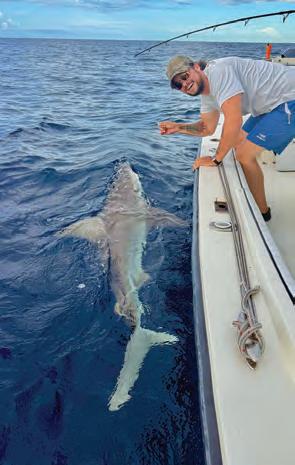
a
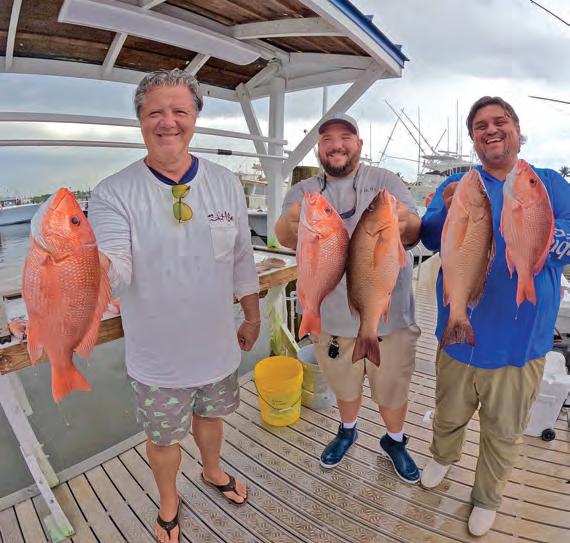
fishing strategy for a day’s outing, a highly desirable option.
August’s relatively calm summer seas will allow fishing crews to explore their near coastal fishing zone. As in all summer months, fishing teams must maintain a healthy concern
near these bait schools off the beach is a great way to find some good action with a variety of said species.
for thunderstorm activity and shape their trips accordingly. So, in August, stock the boat up with plenty of lead and cut bait and target the many species of snapper and grouper that inhabit the near shore waters, east of the shores of Martin County.
Use wire leaders for catching sharks and/or kingfish. Tight lines!

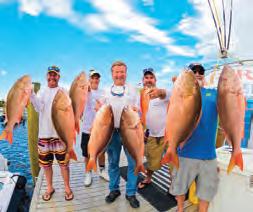
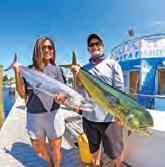
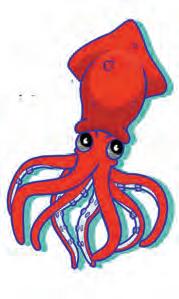
systems and down the beaches early morning and later in the afternoon. Nearshore fishing has been great for snook, tarpon, permit, goliaths, sharks, and schooling jack crevelles. Running the beach is an easy way to find schools of fish for sight fishing opportunities. I also enjoy finding bait schools nearshore this month and fishing in and around them for shots at kingfish, sailfish, bonito, cobia and sharks. Fishing a live bait

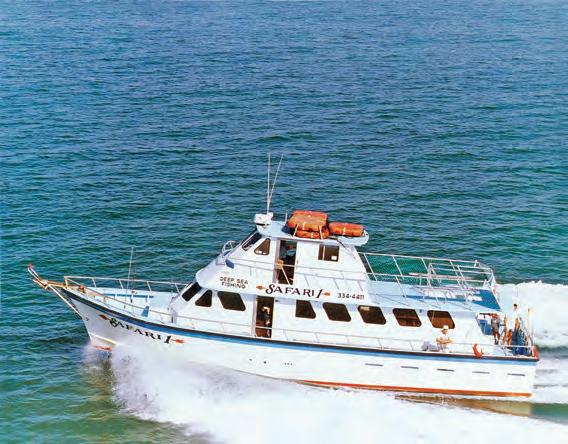


Capt. Bo Samuel
Pullin Drag Charters
(772) 971-6661
facebook.com/Pullin-Drag-Charters catainbofishing@gmail.com
Summer’s in full swing and so are the daily chances of afternoon thunderstorms along with the fact that we are in hurricane season. Even with all that, August brings warmer waters and calmer seas which means plenty of opportunities for summertime fishing. Like captains and anglers everywhere, we take full advantage of good weather windows with plans to head offshore and put fish on deck. Kingfish, mahi, snapper, bonito, amberjack, and sails are consistently being reported as we see these fish follow the plentiful bait schools of threadfins, pilchards, and sardines along the beach. While some may say fishing slows down in August, a great plan and preparation
Capt. Scotty Gold
Miss Fort Pierce Fishing (772) 766-0191
www.fortpiercefishing.com
At the time of writing this article, we’re just getting ready for a nighttime departure for red snapper, long waited for the dates from NOAA. I feel confident that once President Trump signs the order for the four states impacted on the eastern seaboard, that our governor

will still keep you pullin’ drag and make the effort worthwhile.
The mangrove and mutton bite continues strong along our local reefs and wrecks, so bottom fishing is a trusted go-to strategy. I highly recommend starting your fishing trip at sun-up to make the most of your plan and to avoid the typical mid-to-late afternoon storms. Stir up these aggressive feeders by using a chum bag and throwing some cut bait now and then and be sure
will give us more days in the fall.
With August upon us, we must watch and fish in between storms and fronts. August can be a good month as mangrove snappers are finishing their spawn, and the muttons begin to become more active again. Continue to fish the rough bottom with high peaks for the mango snappers and the sand around rough bottom and wrecks for the muttons. Live finger baits and a variety in grump plugs will continue to work best.
During this time mahi-mahi will make their return to the area as the water warms further before making their move down to the southern


to keep your bait on bottom with enough weight.
Offshore we are finding significant bites of cobia, kingfish, amberjack, plus some sails and dolphin. Big kings and cobia are following the bait fish so keep an eye out for any bait pods in the area. I recently had a charter guest land a 44-pound cobia! Some days the kingfish will chew anything you throw and other days they are picky but always be prepared for a hit. Kings commonly pull 100 to
200 feet of drag very quickly. August also gives us the highly anticipated spiny lobster season, a serious tradition for divers that come from around the state. The season opens on August 6 with a lot more boats on our waters as divers choose Fort Pierce as a top diving destination for our spectacular inlet and delicious lobster bounty. Catching limits of tasty Florida “bugs” is a diver’s dream, but if you’re not a diver, trade some scales for tails and enjoy a wellloved August seafood custom.
Did you know my home base, Little Jim Bait & Tackle, is designated as a significant historical site? The original building was built in 1942 for a Navy guard checkpoint during WWII as the Navy took over parts of the barrier islands to establish the amphibious training base. After the war, the guard shack was opened as a bait shop and has been selling bait and cold drinks ever since. Come on over and enjoy history, food, fun, and music, plus we can talk about your next custom fishing adventure! Remember to support our great local bait and tackle shops like Little Jim and DeBrooks Fishing Corner. Just tell them Captain Bo sent you! Wishing you scales and tails and a salty August Pullin Drag!
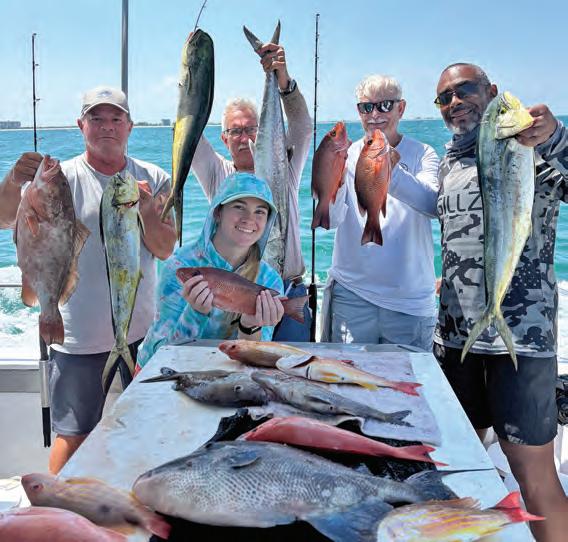
Atlantic for the winter. Look for patches of mahi on the main reef line and in small pockets of fish. It is always good when bottom fishing to have a lighter spinning rod with 20-pound test ready to throw bait on and pitch it out in front of the mahi. If you have small strips of squid, throw several of them right around the boat when you spot mahi, as that entices
them to look for more.
We will continue to fish our schedule throughout August before going to the boatyard to take some downtime and make more improvements to our boat.
Be attentive to the storms, some may be offshore in the flat ocean, but they do make for extremely rough conditions around the inlet.

St. Lucie Flats Fishing Charters (609) 820-6257 www.stlucieflatsfishing.com
Justlike every other year, this one seems to be flying by at an unprecedented speed. It’s August on the Treasure Coast! During the heat of the summer, tides and water temps dictate everything when it comes to planning an inshore outing. Another thing to be mindful of is we are also in the time of year where we start to see the thunderstorms in the morning. They can significantly dictate how, where, and what to target. I’m sure I sound like a broken record…. get out early and get home early to beat the heat.
The seagrass has made another exceptional comeback the year. As a direct result, the forage fish, snook, trout, and redfish fishing on the open flats has been good. Hermans Bay, Big Mud, Bear Point have all been holding good schools of bait. I am a big fan of single hook lures when working the open water. Start off working an area with what we would
call a search bait. Quarter ounce (1/4-oz) spoons, or D.O.A. or Z-Man
Paddle Tails are great for locating fish. Slow things down to a more subtle presentation once you get a few bites to a weedless jerk bait and really start to pick the area apart. Walking the surf is great throughout the month of August as well. Whether you plan on targeting snook and tarpon working the schools of bait or fishing bits of shrimp for jumbo whiting. Either of those can provide several opportunities at some solid rod bending action. Moving back into the river, if you’re looking for groceries, the lane snapper fishing is amazing throughout all the summer months. Work the channel edges with small shrimp or pilchard on a #2 circle hook will keep the rods bent all morning. If you want to weed out the smaller fish use a 3/8th Vudu Shrimp or a Doc’s Goofy Jig. August 6th is the opening day for spiny lobster on the Treasure Coast and throughout the rest of the state. Expect to see lots of boats on the water each day as they head out in search of the spiny critters. Depending on the rain, there can be several boats diving the channel throughout the Intracoastal Waterway. Be mindful of any boats

displaying a dive flag. If you don’t know the regulations visit FWCs website to get a quick refresher.
We are already past the summer solstice and the days are starting to get shorter. The mullet run is knocking at our door.


Capt. Gus Brugger
Capt. Rocky Carbia
Capt. Jonathan Earhart
Capt. Scott Fawcett
Capt. Scotty Gold
Capt. Bo Samuel
Capt. Adam White
Capt. Terry Wildey
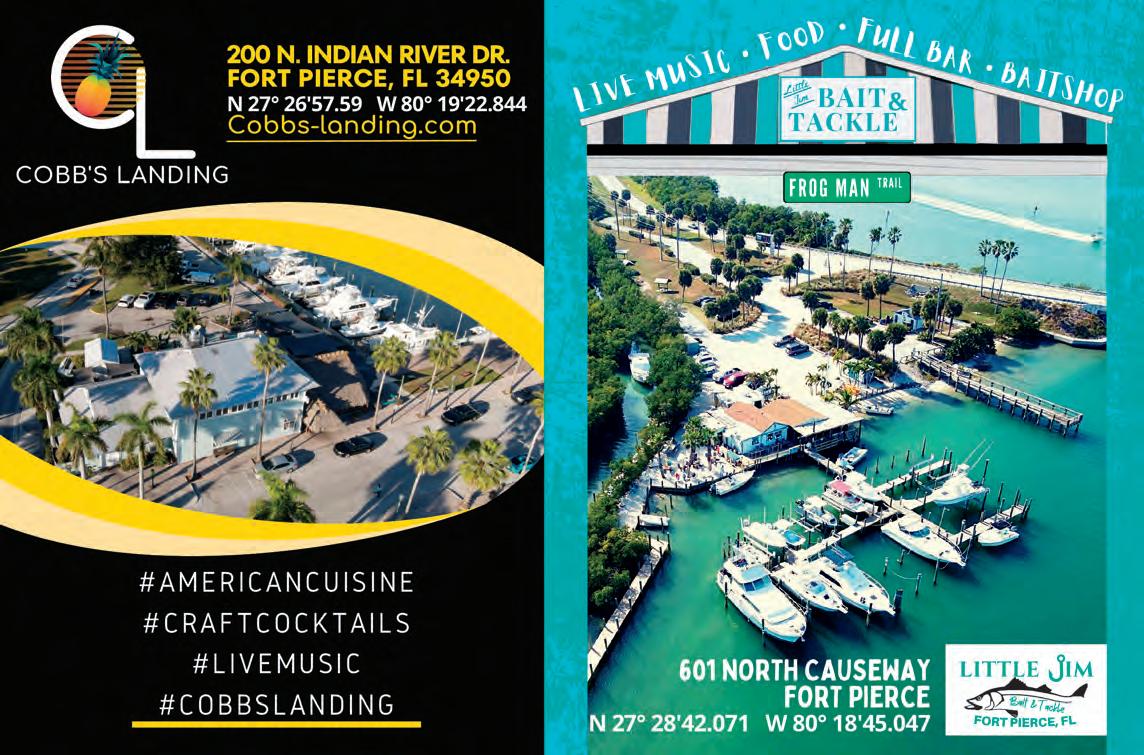





























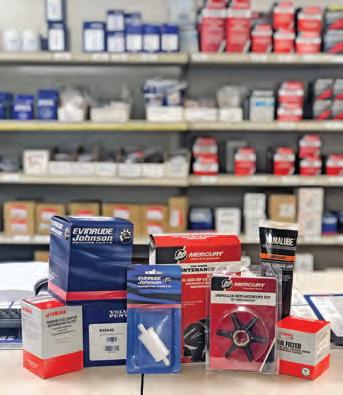
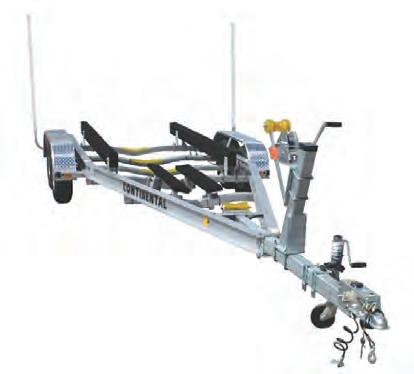







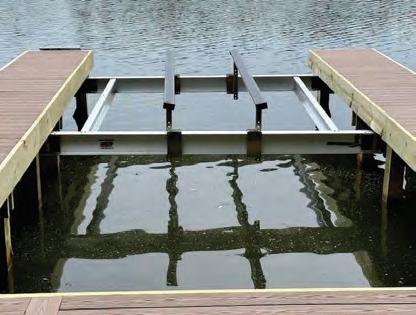
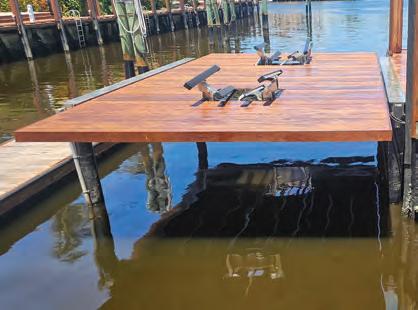
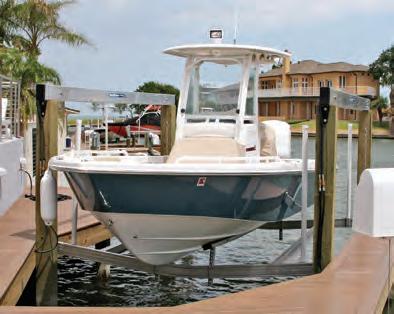


ShoreStation hydraulic boat lifts are a reliable choice for coastal residents and boating enthusiasts alike. Their strong construction, made with corrosion-resistant materials, allows them to withstand harsh environmental conditions, including sun, storms, and saltwater damage. ShoreStation provides a steadfast solution for protecting waterfront investments, o ering peace of mind to owners in the Sunshine State.
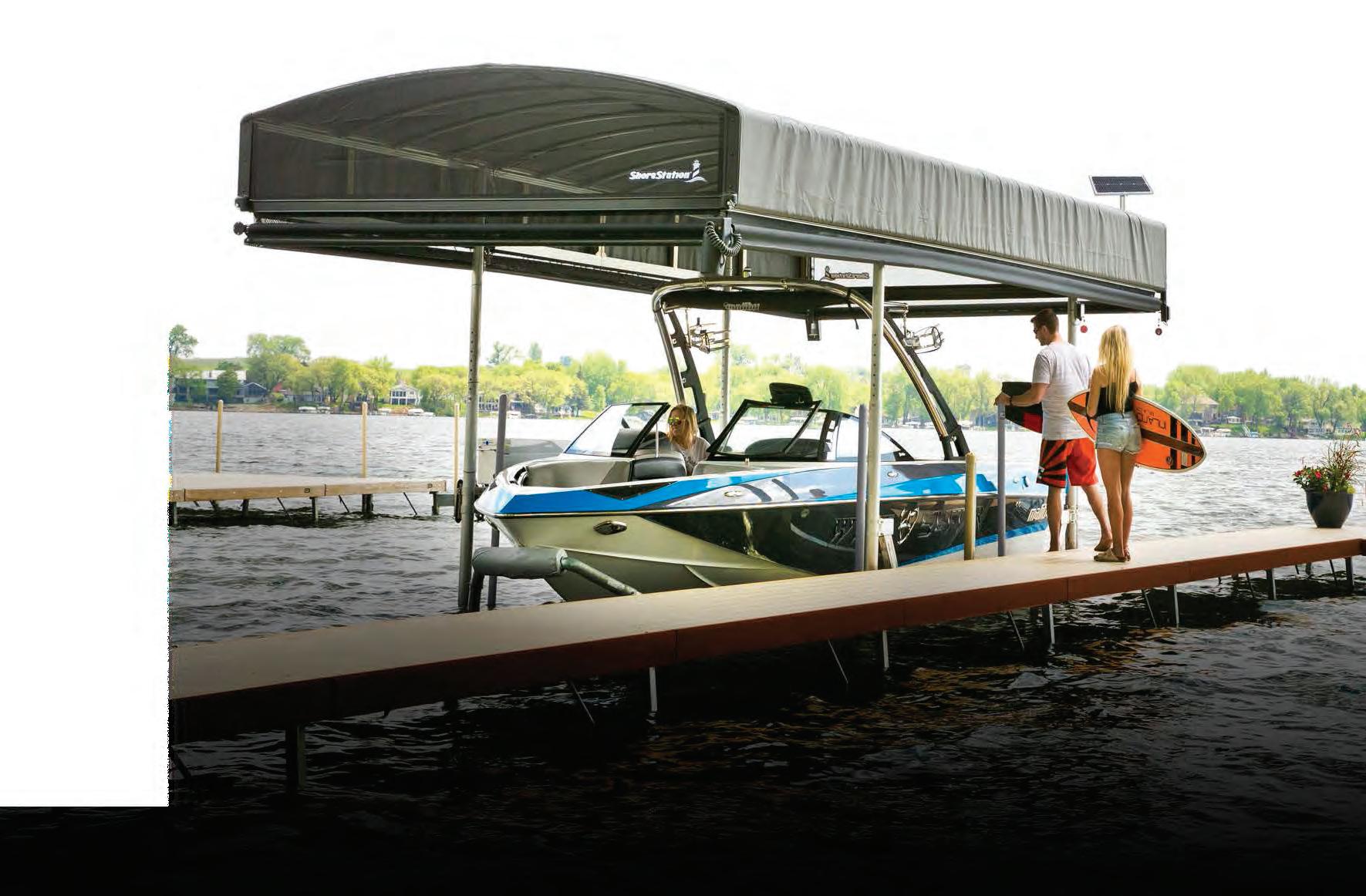
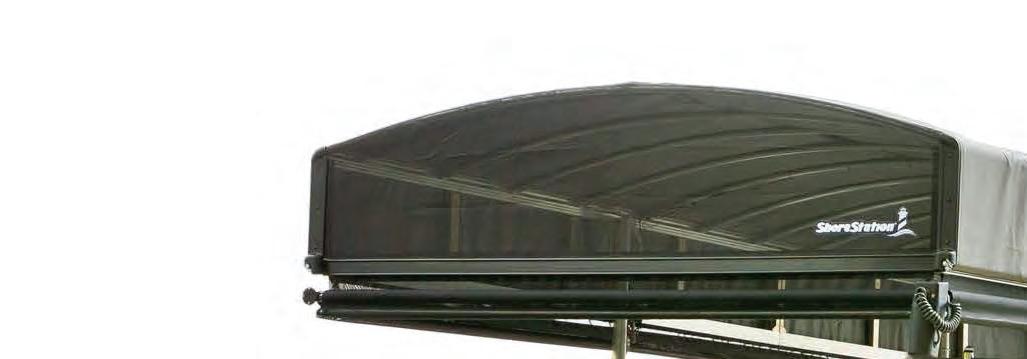
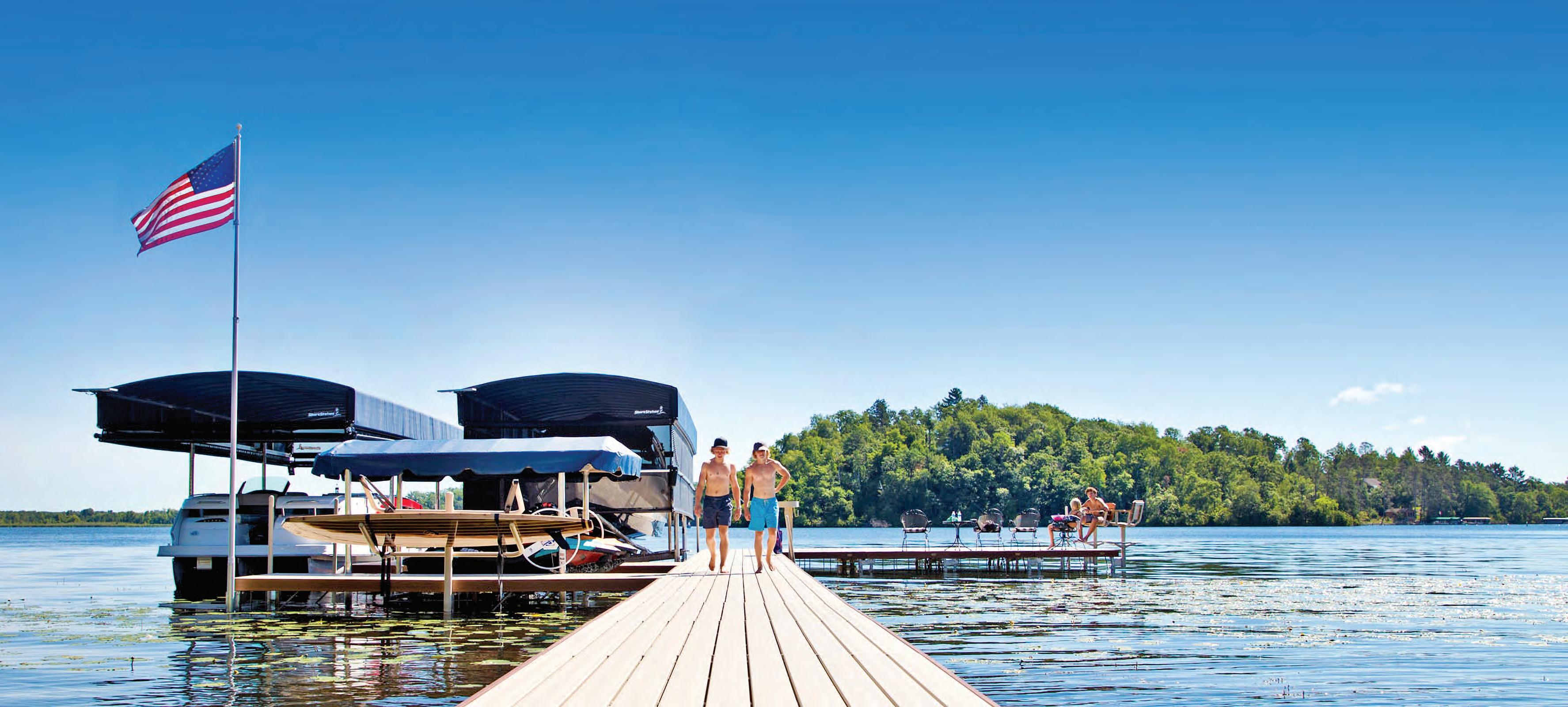


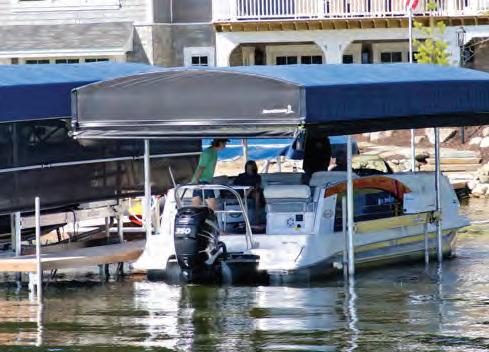
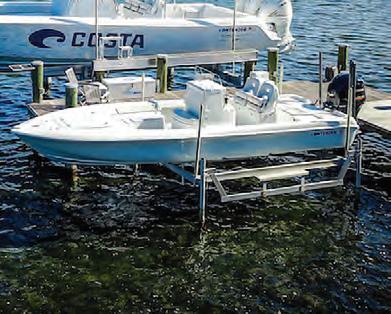
Equipped with exceptional weather resistant fabric and breathable SunTex 80 woven mesh ends for maximum protection and durability,

Made from the highest quality materials, our innovative hydraulic boat lift is one of the fastest and safest lifts on the market today. When you have a hydraulic lift, there’s no need to worry about wind and waves getting in your way. This lift will give you con dence to safely land and secure your boat in less-than-ideal conditions.
Never miss another moment on the water. Power your lift with clean, free solar power. Our speedy 20 watt charger features solar regulator drainage protection, saving your battery from permanent damage caused by overcharging.



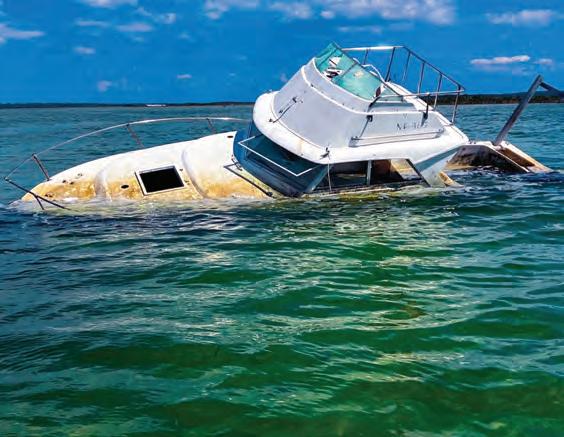
The Florida Fish and Wildlife Conservation Commission (FWC) is preparing to implement a new law aimed at strengthening vessel accountability and enhancing protections for Florida’s waterways. Senate Bill 164, signed into law by Governor Ron DeSantis on June 19, went into e ect on July 1, 2025. is legislation is designed to help reduce the number of at-risk and derelict vessels across the state and improve enforcement tools for FWC o!cers and partner agencies. Key provisions of the new law include:
• Clari ed Ownership Standards: e de nition of “vessel owner” is clari ed, and a valid vessel title will now serve as prima facie (presumed) evidence of ownership.
• Stronger Requirements for At-Risk Vessels: Vessel owners must now complete an E ective Means of Propulsion (EMP) evaluation upon request by law enforcement. If an o!cer has reason to believe the vessel lacks an e ective means of propulsion and the owner is present, the evaluation must be conducted immediately or within 48 hours if noti ed otherwise.
• Public Nuisance Vessel Designation: A vessel may now be declared a public nuisance — subject to removal like a derelict vessel — if the owner
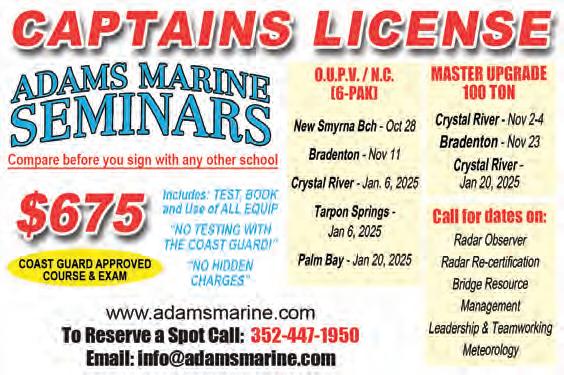



receives three citations related to any at-risk conditions within a 24-month period, including unpaid citations or failures to appear in court.
• Expanded Noncriminal Infractions: Violations such as expired registration and long-term anchoring may now be addressed through mailed noncriminal citations from law enforcement.
• More Flexible Use of Removal Funds: Derelict Vessel removal funding may now be used not only for removing DVs but also for preventive removals under the Vessel Turn-In Program and for public nuisance vessels.
• Harsher Penalties for Repeat DV O enders: First o ense - First-degree misdemeanor; Second o ense - ird-degree felony; ird o ense - Seconddegree felony.
• No Liveaboard on Derelict Vessels: It is now a rst-degree misdemeanor to live aboard a vessel that has been declared derelict by the court or the owner has not requested an administrative hearing.
“We have seen increasing success in our e orts to combat the ongoing derelict vessel problem in Florida’s waters,” said Capt. Travis Franklin, leader of the FWC Derelict Vessel Removal and Prevention Program. “ is new legislation enhances our e orts to not only remove derelict vessels but also prevent at-risk vessels from becoming derelict.”
Derelict vessels remain a priority for the FWC, and the multi-year initiative to reduce the number of derelict vessels on Florida’s waterways is ongoing. ese vessels pose serious risks to seagrass beds, marine life, navigation, public safety and property. e Boating and Waterways Section is leading this statewide e ort in partnership with local governments and law enforcement.
Leaving a vessel in a derelict condition is a crime. Derelict vessels, including those that are sinking, grounded, stripped or lacking vital systems, threaten both people and Florida’s natural resources.
FWC has removed nearly 200 vessels through the Vessel Turn-In Program and is actively taking applications from at-risk vessel owners. Vessel owners can call VTIP specialists at the FWC for more information on the program at 850-488-5600 or visit the VTIP website at MyFWC.com/boating and click on “Vessel Turn-In Program” on the second slider at the top of the page.
For more information on derelict or vessels at risk of becoming derelict, visit MyFWC.com/Boating and select “Waterway Management” followed by “Derelict Vessel Removal Program.”
Florida Fish and Wildlife
Conservation Commission (FWC)
O!cer Wil Raker certi ed a new state record spotted bass, caught by angler Joe Durden from Blountstown.
e sh weighed 3.93 pounds and measured 18.25 inches in length.


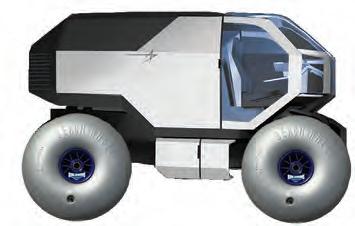


Durden was excited to catch his spotted bass on the Apalachicola River during the Fi h Annual Liberty County Bulldog Booster Bass Tournament out of Bristol Landing.
“I knew right away this was potentially a state record,” said Durden. “ is was the biggest spotted bass I had ever seen on the river.”
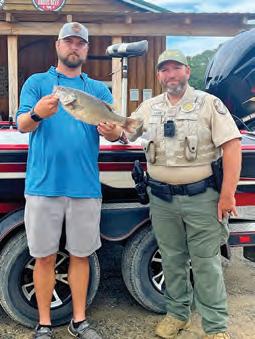
Durden, an avid bass tournament sherman, caught his spotted bass on a crankbait while using LiveScope technology. A er landing the sh, an FWC freshwater sheries biologist met with Durden to discuss his catch and verify it was a spotted bass.
“Catching a state record sh is a tremendous accomplishment for any angler,” said Andy Strickland, sheries biologist with FWC’s Fish and Wildlife Research Institute. “Particularly a record that’s held the test of time for 40 years.”
e previous spotted bass state record was 3.75 pounds, caught by angler Dow Gilmore on June 24, 1985, on the Apalachicola River.
Anglers can check state records by visiting MyFWC.com/Freshwater and clicking on “State Record Fish.”
It’s no fsh tale when you run with a John Deere. You can get everything done faster and easier, so you get more time on the water. Plus, our special offers make them the catch of the day.



The boating industry is jumping onboard with Dometic’s revolutionary DG3 Gyrostabilizer, due to its groundbreaking spin-up and spin-down times, energy e%ciency and superior performance in all types of sea conditions. is solution has literally taken vessel stabilization to a “Whole New Level,” capturing the attention of boaters and boat builders around the world. e !rst in a planned line of advanced stabilization solutions by Dometic, the new DG3 is targeted at the 35- to 41-foot !shing boat market.
Soon a er Dometic won the 2025 NMMA Innovation Award at the Miami International Boat Show for the DG3, leading American boat builder Regulator Marine announced that its new-for-2025 Regulator 35 Center Console would be o ered with Dometic’s DG3. “We are honored to have a respected builder like Regulator come onboard,” said Dometic Marine Segment President Eric Fetchko. “ eir latest center console agship is an ideal match for our system in terms of size, hull performance, overall quality and a wide range of premium features and technology. It’s also a wonderful platform to showcase our advanced capabilities, including energy e%ciency that enables o shore use without the need for an onboard generator,” added Fetchko.
e DG3 reduces spin-up time by more than 65%, reaching full readiness in just 16 minutes, compared to the typical 50 minutes required by current systems in the market. is means you’ll
get out on the water and out to distant !shing grounds faster. e system’s downtime is equally impressive, fully lowering in just 20 minutes, a signi!cant improvement over the eight or more hours (15X faster) required by current systems.
Dometic also pioneered innovations in energy storage and recapture, enabling the battery to recharge e%ciently. DG3 uses Dometic’s proprietary, industry-proven Inverted Roller Screw technology for true dynamic control and signi!cantly improved roll reduction performance over a wide range of sea sates. In addition, the push-pull motion of Dometic’s all-electric procession actuator is used to create power that contributes to running the system. During spin down, Dometic’s regenerative braking technology recharges the system’s dedicated 48V Lithium-Ion spin-up battery for the next use. Overall, the DG3 reduces power consumption by an impressive 40% compared to other gyros on the market.
DG3’s Inverted Planetary Roller Screw technology and proprietary all-electric procession actuator provide dynamic control of the gyro hemisphere for instant response to vessel movement and superior comfort over a full range of sea states. is allows DG3 to react faster to heavy wave motions, while also smoothing the ride in small and long period waves, where current gyros are less e ective.
Durability and reduced maintenance were also key goals for Dometic engineers. Dometic’s


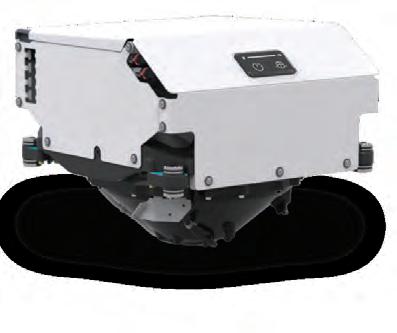
durability, minimizes required service, and reduces total cost of ownership. Featuring a slower-spinning ywheel, larger, more robust bearings, patentpending inner race cooling, parallel path cooling, and a titanium heat exchanger, the DG3 is designed to stay cool and operate reliably for the long run.
Dometic designed the DG3 as an easy “dropin” replacement for other comparably sized systems available in the market today. e DG3 !ts within the same footprint and clearance speci!cations and features reversible mounting feet to address common challenges encountered by installers. To meet the needs of today’s boating market, Dometic’s DG3 is compatible with 12-, 24- and 48volt house battery systems.
To learn more about how Dometic’s DG3 can take your o shore shing adventure to a whole new level, visit www.dometic.com.





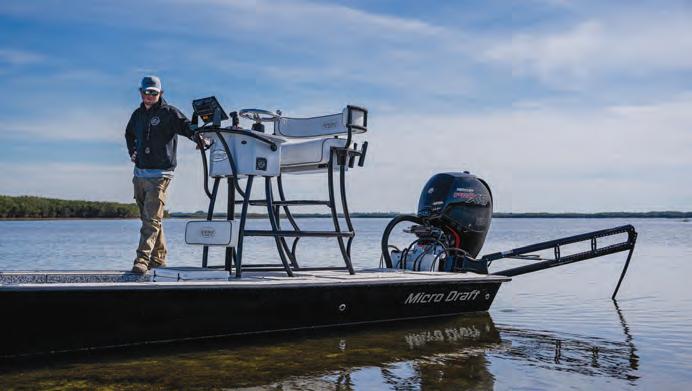



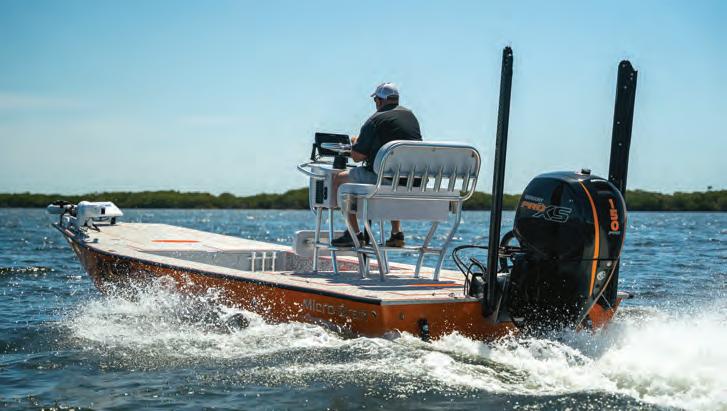




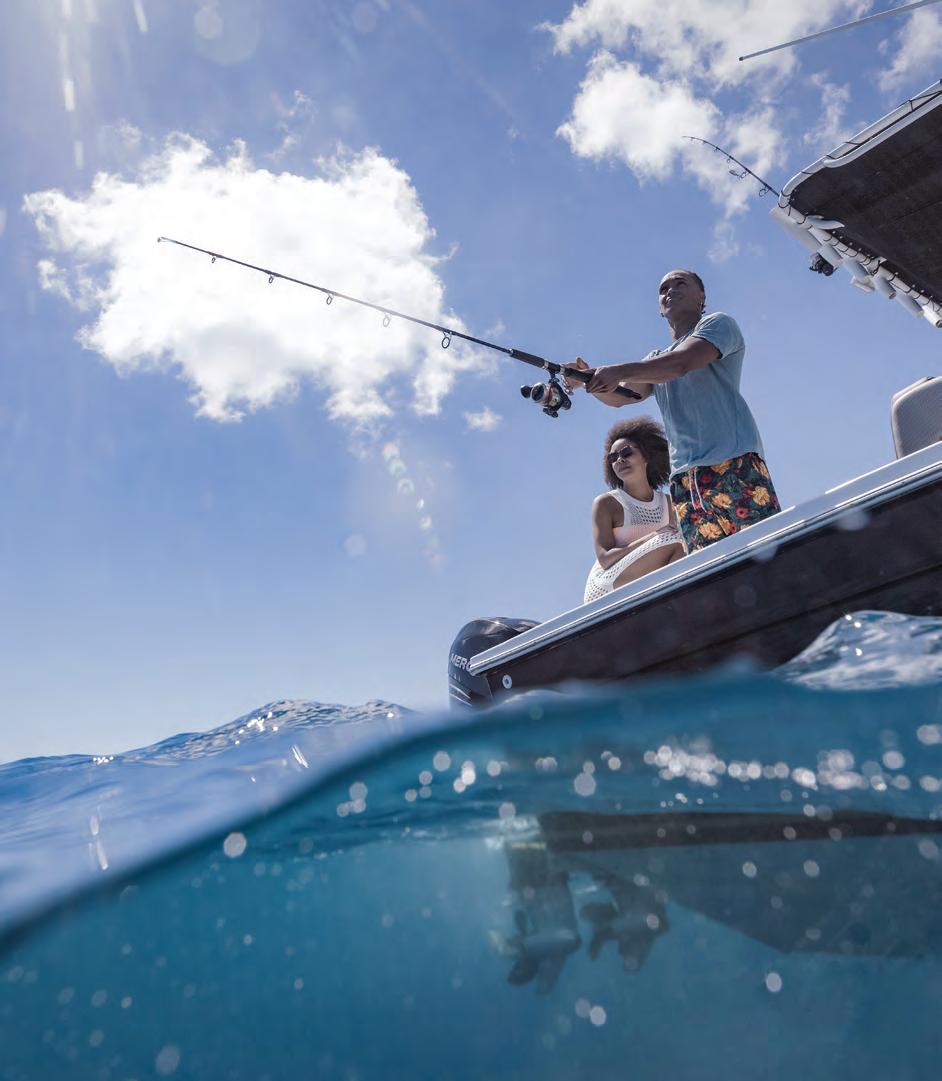
Nestled in the heart of the Caribbean, the US Virgin Islands embody a harmonious blend of natural beauty, cultural vibrancy, and laid-back serenity. ese islands are more than just a picturesque getaway; they are a living testament to nature’s rhythm and resilience, e ortlessly in tune with the world around them.
With no passport required for U.S. citizens, from the moment you arrive, the islands’ natural rhythm is palpable. e gentle sway of palm trees, the soothing sound of surf crashing against sandy shores, and the vibrant melodies of local music all echo the heartbeat of this tropical paradise. e islands’ lush landscapes, with their verdant hills and crystal-clear waters, mirror the steady pulse of life that sustains the local ecosystems and communities alike.
e US Virgin Islands’ environment is a symphony of biodiversity with world class shing and diving. ese natural elements are not static; they dance in harmony, in uenced by the tides, wind, and seasonal changes—further emphasizing the islands’ intrinsic rhythm. is delicate balance underscores the importance of conservation e orts, ensuring that future generations continue to experience the islands’ natural cadence.
Culturally, the US Virgin Islands are equally in tune. e music, dance and festivals re ect a vibrant heritage rooted in African, European and Caribbean traditions. e spirited calypso beats
and reggae rhythms are expressions of life's ongoing dance—celebrating resilience, community and joy. ese cultural expressions are an extension of the islands’ natural rhythm, showcasing how human life here moves seamlessly with nature’s ow.


In a world o en dictated by chaos and rapid change, the US Virgin Islands serve as a reminder of the beauty of being in sync with nature’s tempo. eir natural, cultural and ecological rhythms o er
a blueprint for sustainable living and harmony. As travelers and residents alike continue to embrace this rhythm, they uphold a legacy of balance—one that celebrates life’s natural ow and the enduring spirit of these remarkable islands. In the US Virgin Islands, being in rhythm isn’t just an ideal; it’s a way of life.

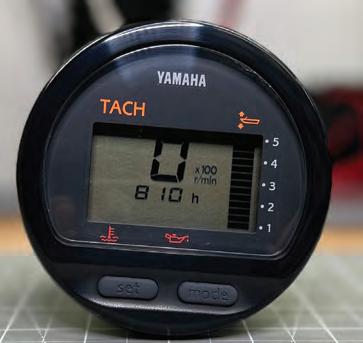

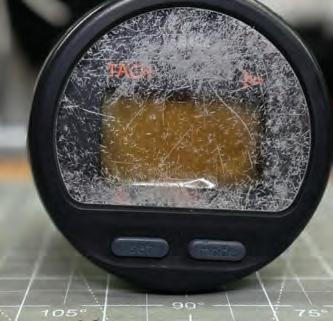


In some parts of the country the bass spawn is already starting to come to an end like it is down here in Florida and others may not start up for another couple months. Regardless of your phase, this post spawn !shing tip should help you dial in your !shery when the time is right for you! One thing is the same for every !shery and every species of bass a er they spawn, they are hungry! is can create some awesome and fun !shing opportunities that have led me to some of my best days on the water.
Typically a er the largemouth bass spawn, there are other !sh that will then begin their spawn. I’m not a scientist, but I’m sure this has a lot to do with the speci!c timing of why the bass do their thing when they do. In most areas of the southern United States, I know that the bluegill and o en times the shad, if they are in your lakes, will start to spawn very shortly a er the bass !nish up. Bass will use every advantage they can when these bait!sh group up to feed back up a er a long couple weeks or months protecting their eggs in the shallows and this can make for some fun !shing.
Smallmouth bass and spotted bass are very similar as well in the aspect of taking advantage
TYLER WOOLCOTT

of bait schools when they get in that post spawn phase. I have seen them group up and attack shad, perch, alewife schools and any other bait that is readily available to them. Typically I do a lot of my searching for these things with my electronics and forward facing sonar which is a very helpful tool for learning !sh activity and seeing what’s going on under the surface of the water.
Most of the time you can use clues you can visually see with your eyes to help you !nd this feed that is going on. Typically birds feeding on the water is an awesome sign of a feeding frenzy and that is one thing I ALWAYS look for. Also always keep your eyes peeled for !sh blowing up on the surface or shad ickering as well. Sometimes the very smallest clue can lead you to much larger picture. Birds standing on speci!c banks, the sound of bluegill popping around vegetation, anything that clues you in to bait in the area usually means the bass aren’t very far.
Hopefully this tip will help you when the !sh in your area get into the post spawn feed! Find the bait, you will !nd the bass! I always try to duplicate the bait!sh with whatever kind of lure you are throwing. Bluegill eaters - I will

throw a frog or a swimming in bluegill colors, etc. Shad eaters - I will throw white or silver topwaters and crankbaits, etc. Always match the hatch if possible! Good luck out there this season and tight lines!
Tyler Woolcott is a professional tournament angler and guide. Check out his website at www.tylerwoolcott shing.com.


“I never expected it to be so beautiful that it takes your breath away.”
— Kaya C., on Stauer Opals
In a quaint village, nestled between rolling hills, lived a young woman with a deep appreciation for gemstones. Her grandmother gifted her a delicate cross pendant adorned with opals. "e opals shimmered with a mesmerizing play of colors, reflecting hues of blues, greens, and fiery oranges. Her grandmother shared the legend of the opals, believed to bring hope, purity, and luck to those who wore them.
Using this story as inspiration, Stauer brings you the Opal Spirit Cross Pendant. With over 2 total carats of Kyocera lab-created opals set in .925 sterling silver encased in yellow gold, this pendant is a radiant celebration of beauty and craftsmanship. Each opal captivates with a kaleidoscopic dance of fiery oranges blending into oceanic blues, streaked with flashes of vibrant green that seem to come alive with every movement. "e shimmering opals are skillfully arranged to create an enchanting, otherworldly glow, embodying the spirit of hope and harmony.
"is breathtaking combination of color and craftsmanship is available as a limited availability of

only 930 pieces, making it a rare and treasured addition to your jewelry collection. Plus, when you order today, you’ll receive the gold-!nished sterling silver chain—a $69 value—absolutely free!
Don’t miss your chance to own this exclusive tribute to timeless elegance and meaningful symbolism. Necklace Speci!cations:
• 2 ½ ctw. Kyocera lab opals and DiamondAura® accents
• Yellow gold-finished .925 sterling silver setting
18"
silver



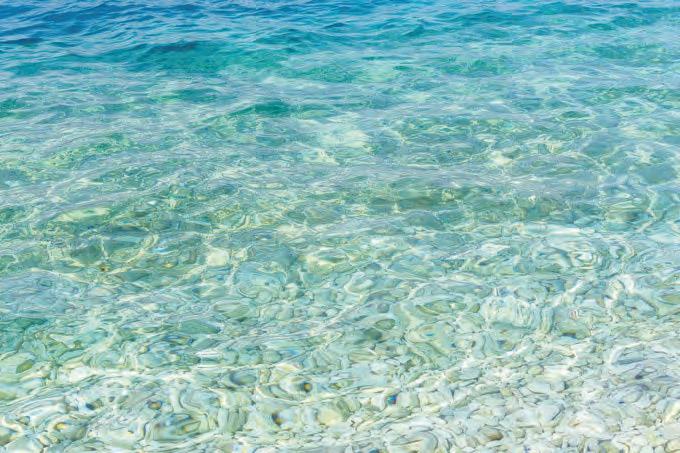




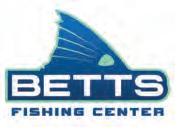
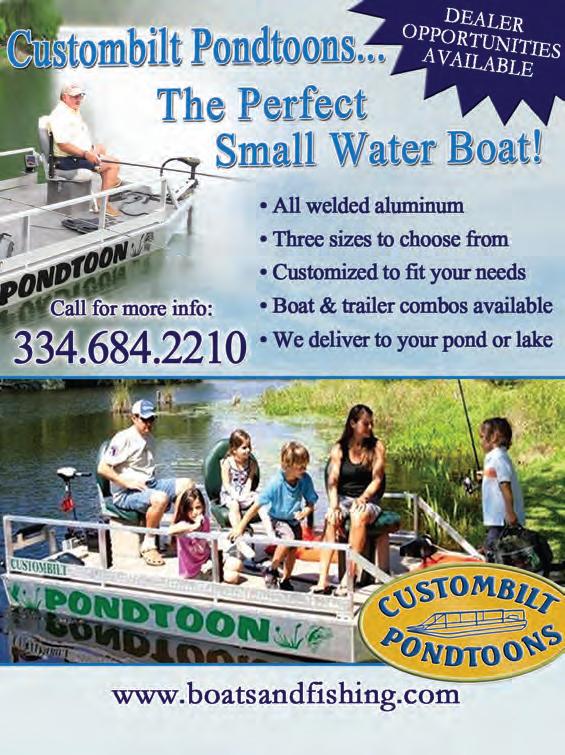

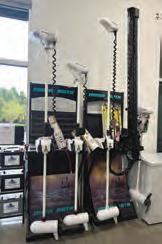

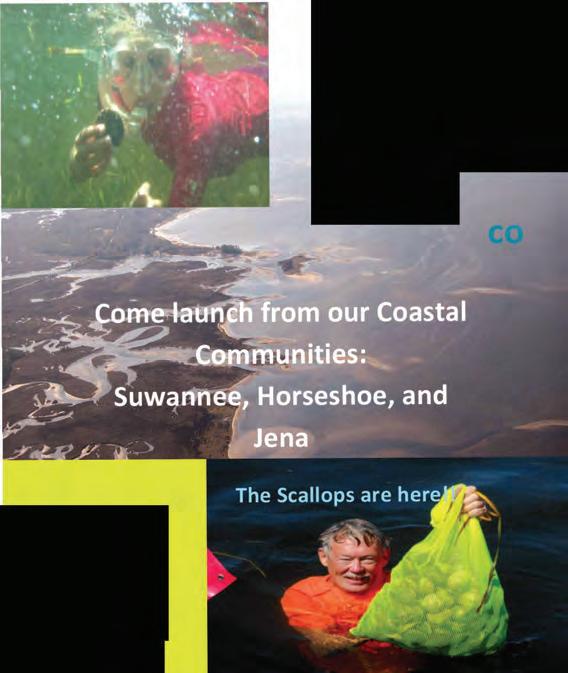



The quest to find the ultimate men’s watch has traditionally been a difficult one in the world of fashion. A timepiece with the perfect look and functionality has long been the goal of both watch designers and enthusiasts alike.
The Renegade Blue Chronograph Men’s Watch is the perfect combination of style and function. With a sleek design that features a bold blue dial, rose gold hands and hour markers, and a durable sports silicone band, this timepiece will instantly elevate any outfit.
The three sub-dials provide a precise timekeeping function. The sports silicone band is durable yet comfortable, providing a secure fit that won’t slide around on your wrist. The band is also easy to clean and maintain, making it perfect for everyday wear. The watch’s 30 Metre Water Resistance rating ensures that it has you covered whatever the occasion.
The Renegade Blue is also built to last, with a sturdy stainless steel caseback and exquisitely detailed bezel. The watch is powered by a super reliable quartz movement, which is covered by our incredible 5 Year Movement Warranty - ensuring accurate timekeeping for many years to come!

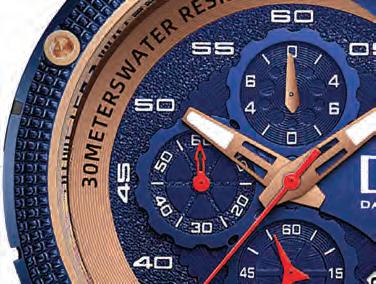

At the amazingly low price of just $99 plus S&H, this watch is an absolute steal. Don’t miss out on the chance to own the Renegade Blue and Rose Gold Chronograph Men’s Watch - order yours today!




